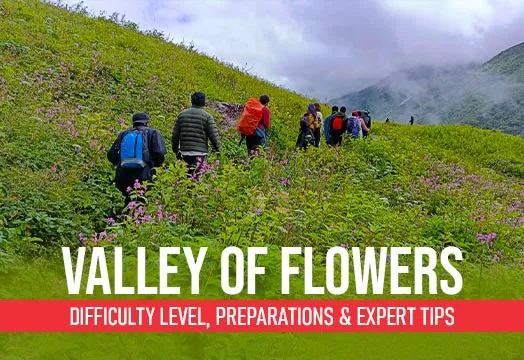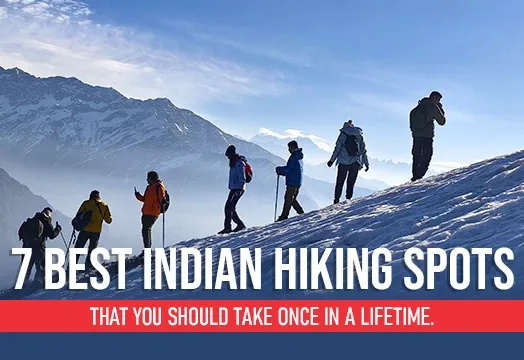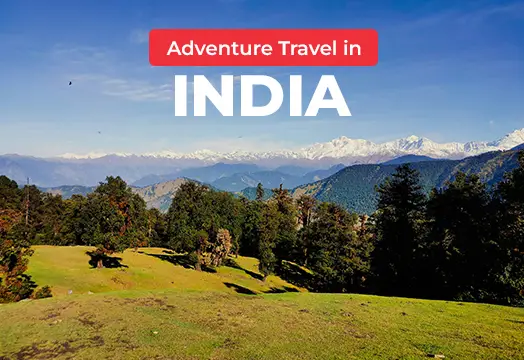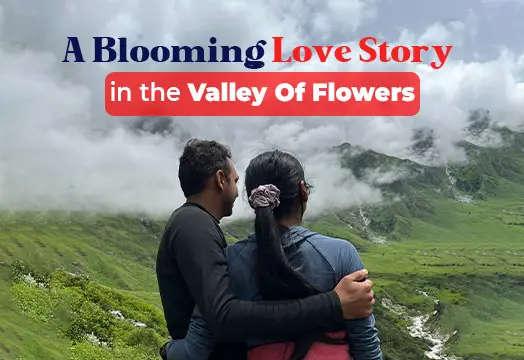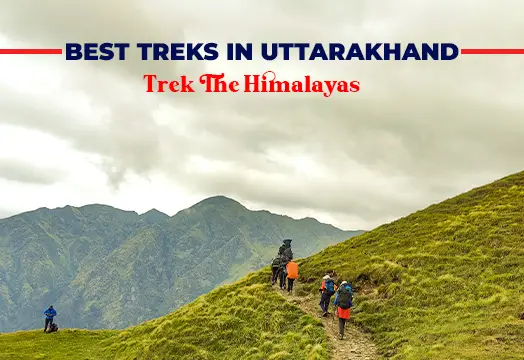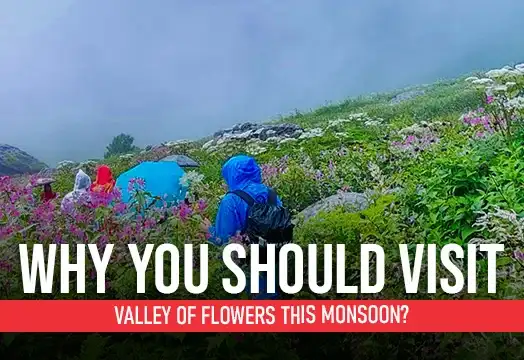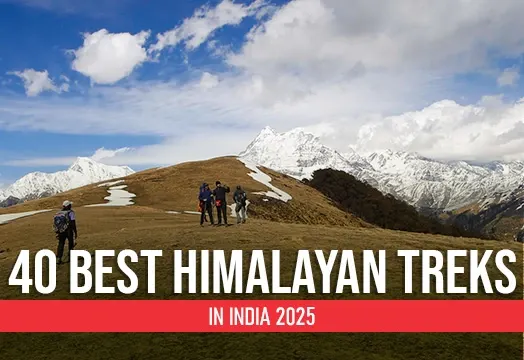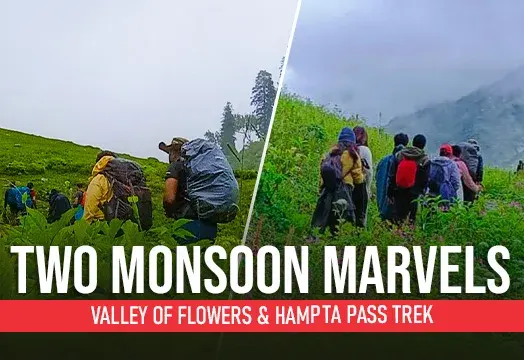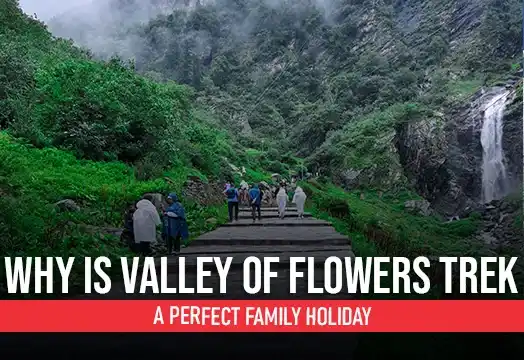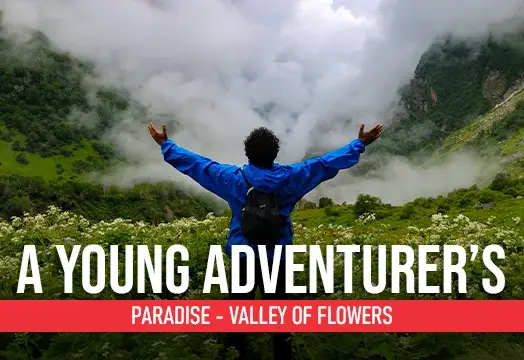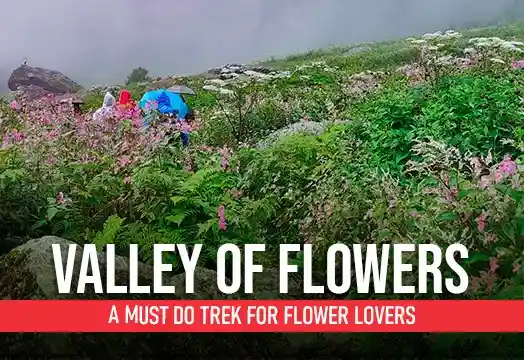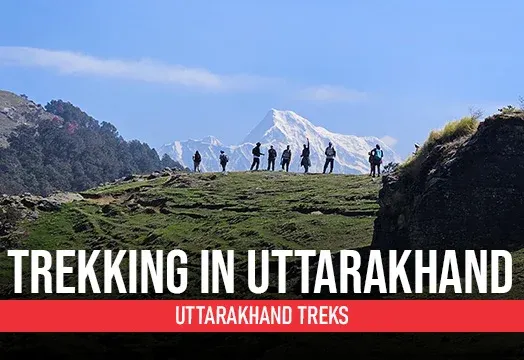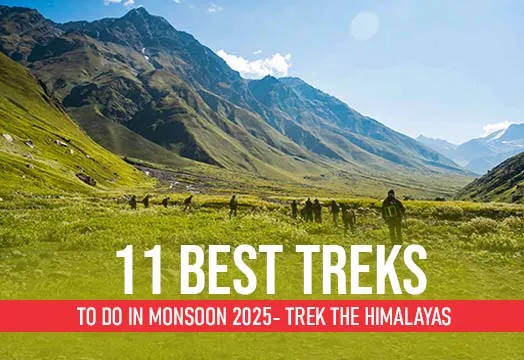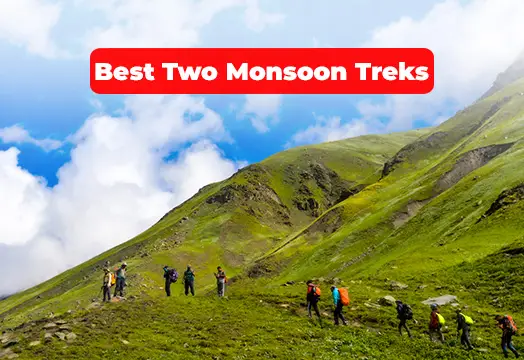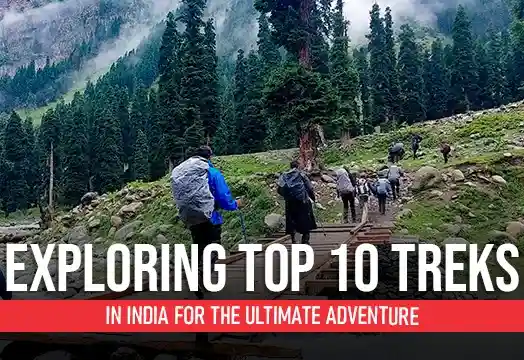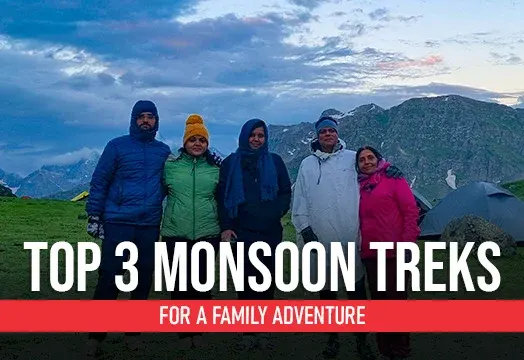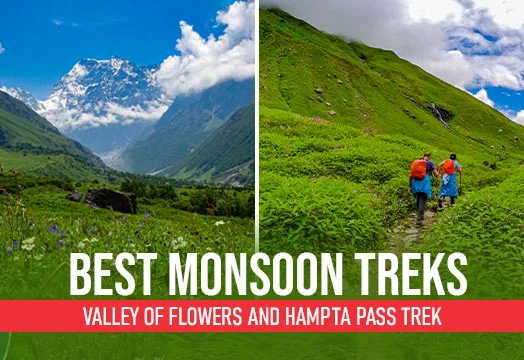
Region
Uttarakhand | India

Duration
6 Days

Max Altitude
14100 Ft.

Trekking Km
37 KM

Grade
Easy to Moderate
Get in Touch with Our Trek Expert
91 7351523841 info@trekthehimalayas.comMonday - Saturday: 10 AM to 06 PM (GMT +5:30)
11800 /Person
- July-2025
- August-2025
- September-2025
- 5% GST will be applicable on Trek Cost and Add-ons
- Meeting Point( Pickup/ Drop Point): Back stayz Laxman Jhula Near SBI Bank Tapovan, Rishikesh (If transportation is opted from TTH)
- Reporting Time: 6:00 am
- Drop Time: 6:30 pm to 7:30 pm (Timings are subject to change based on weather and road conditions).
- Please reach Rishikesh a day before to avoid any delays.
Add-ons
Insurance 210
- Insurance is mandatory.
- It is available for Indian citizens only.
- Non-Indians have to take insurance on their own.
- If you already have the high altitude trekking insurance, email for a refund after booking.
- The cancellation policy will be implemented in accordance with the trek cancellation policy.
- For more details about insuranceclick here
Offload 1000
- Backpack offload is optional.
- Choose add-ons during booking. If missed, log in and add them later.
- Book offload at least 10 days before the trek.
- For offline bookings at the base camp, a convenience fee of Rs. 1500 applies.
- Cancellations made before the trip date will receive a full refund.
Transport 2500
- Transportation from Rishikesh to Pipalkoti, Govindghat to Pulna (to and fro), and a visit to Badrinath. The total transportation cost is ₹2500 per person.
- If you are arriving in your own vehicle at Pipalkoti, you only need to pay ₹1000 for the Govindghat to Pulna(to & fro) and Badrinath visit.
- Choose add-ons during booking. If missed, log in and add them later.
- Book transportation at least 10 days before the trek.
- Cancellation 4 or more days before the start of the trip results in a 100% cash refund.
- Cancellations made less than 4 days before the trip's start result in a 50% cash refund.
- Cancellations made on the trip date are not eligible for a refund.
Get in Touch with Our Trek Expert
91 7351523841info@trekthehimalayas.com
Monday - Saturday: 10 AM to 06 PM (GMT +5:30)
Overview
Trek Name: Valley of Flowers Trek
Days: 6
Adventure Type: Trekking
Base Camp: Pipalkoti
Season:Monsoon |
Month:June | July | August | September |
Country: India
Altitude: 14100 Ft.
Grade: Easy to Moderate
Rail Head: Haridwar/Rishikesh is the nearest rail head to the base camp
Stay: Triple or Dormitory basis only(Separate for male & Female)
Food: Meals while on trek & at Hotel/Guesthouse (Veg)
Location: Uttarakhand
Distance: 37 Km.
Trail Type: Point to point trail | Camping at the same location upon returning.
AirPort: Jolly Grant Airport, which is 21 km away from Rishikesh
Highlights:
- 5% GST will be applicable on Trek Cost and Add-ons
- Meeting Point( Pickup/ Drop Point): Back stayz Laxman Jhula Near SBI Bank Tapovan, Rishikesh (If transportation is opted from TTH)
- Reporting Time: 6:00 am
- Drop Time: 6:30 pm to 7:30 pm (Timings are subject to change based on weather and road conditions).
- Please reach Rishikesh a day before to avoid any delays.
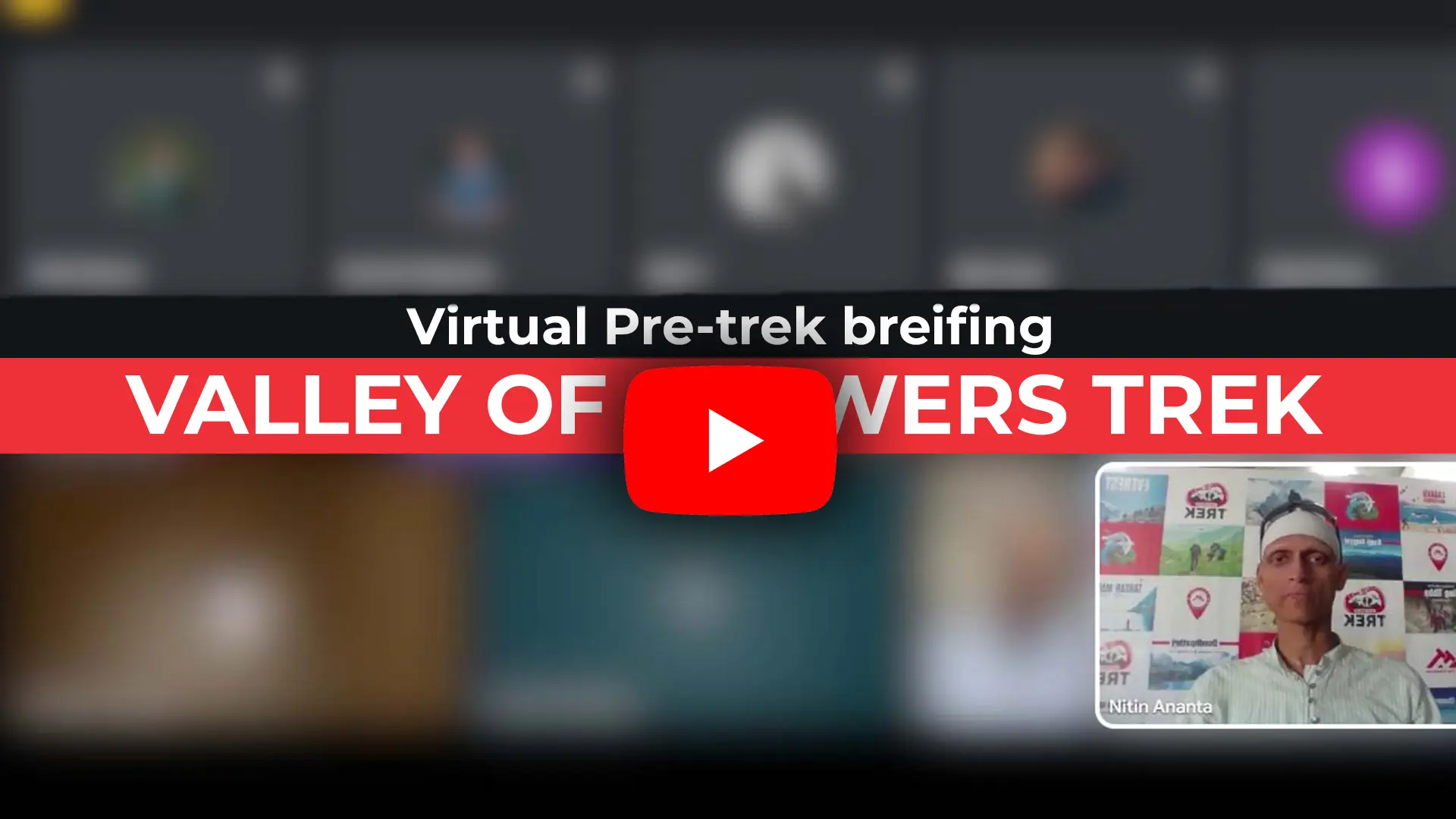
Why is Valley of Flowers a Must- Do Trek?
- As the name suggests, “Valley of Flowers”, the highlight of the trek is a stunning valley adorned with vibrant flowers that stretch endlessly across the landscape.
- The trek is renowned for its blooming alpine flora, with over 500 species of rare and colorful flowers, including the iconic Brahma Kamal and Himalayan Blue Poppy.
- One of the key highlights of the journey is a visit to Hemkund Sahib, one of the highest Gurudwaras in the world. It is not only a sacred site but also a stunningly scenic location.
- The Valley of Flowers is recognized as a UNESCO World Heritage Site, celebrated for its exceptional natural beauty and surreal environment.
- On the way, you pass through beautiful Himalayan villages like Pulna and Ghangaria. Ghangaria serves as the base for both the Valley of Flowers and Hemkund Sahib treks.
- The trail has mesmerizing views of cascading waterfalls, clear streams, lush green meadows, and vibrant mountain scenery. The rich colors of the valley, diverse wildlife, and majestic landscapes provide endless opportunities for photography.
- You’ll witness a dreamlike landscape, standing amidst a natural floral carpet with misty peaks rising all around.
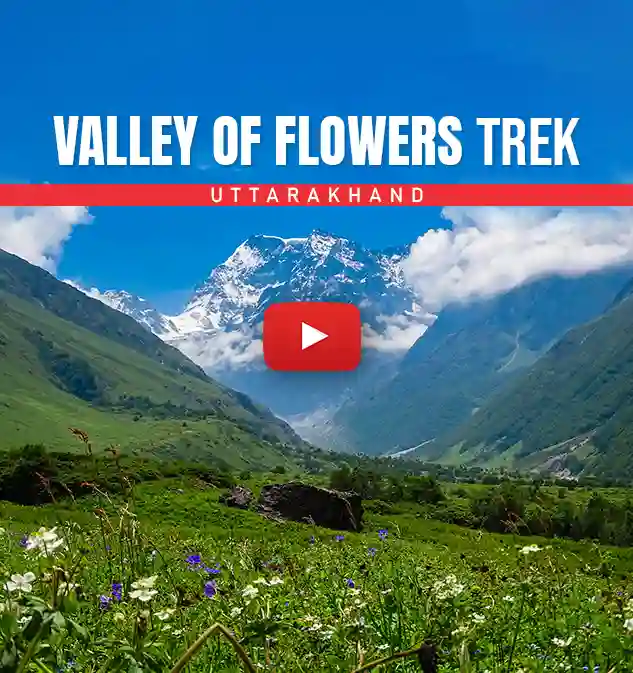
Who Can Participate
- Age Requirement:
- Minimum 9 years
- First-timers are welcome, though prior trekking experience is preferred. Good fitness is a must.
- Fitness Criteria:
- If the trekker wants to carry a backpack then he/she should be able to carry a 10-12 kg backpack. If opt Off-load option then the trekker should be able to carry a 3-5 kg backpack.
- If a trekker's BMI is more or less than the normal range (18-29), please consult our Trek Coordinator before booking.
Special Offer
Special Offer: Trek As Many Times as You Want!
At Trek The Himalayas, we understand that sometimes the unexpected happens, and you may not be able to complete your trek. Whether you are unable to finish the trek, or you’ve successfully completed it and want to experience it again, we have a special offer for you!
Make a single payment and trek the number of times you want.
Terms and Conditions:
- This offer is non-transferable.
- Valid only for Trek The Himalayas limited fixed departures.
- The offer is valid for 5 years from the trek departure date.
- The offer does not apply if the participant has received a cash refund or voucher at the time of cancellation or transferred the trek.
- Participants are not required to pay for the trek cost again but will need to cover transportation and trek permit costs.
- To reserve your spot, you can use our online booking form or simply give us a call. A deposit must be wired, including the initial payment, for confirmation.
- The offer will be activated once the participant reaches the trek base camp/meeting point.
- Trek The Himalayas reserves the right to revoke this offer without refund if a participant violates safety norms, trek rules, or code of conduct; is blacklisted for misconduct, false information, or payment issues; or damages TTH’s brand or reputation.
Valley of Flowers Trek Itinerary
Rishikesh to Pipalkoti
- Altitude: 1,340 m/ 4,400 ft.
- Drive Distance: 200 km.
- Driving Time: 9-10 hrs.
- Pick up from Rishikesh TTH office 06:00 am.
- Driving Time-9-10 hrs.
- The last ATM point is available in Pipalkoti.
- Market available in Pipalkoti.
- Networks are available all along the way.
- Guest house stay (Shared Accommodation).
Route
- Rishikesh to Devprayag (confluence of Bhagirathi River and Alaknanda River).
- Devprayag to Srinagar.
- Srinagar to Rudrapryag (confluence of Mandakini River and Alaknanda River).
- Rudrapryag to Karnprayag (confluence of Pindar River and Alaknanda River).
You will begin your journey with us from Rishikesh. Starting the drive from Rishikesh from the appointed pickup point TTH office in Tapovan, we will take the fabled Badrinath Road.
The nine-hour drive to Pipalkoti will surely be long and arduous, but you are never going to run out of mesmerizing views. The great river running with us on parallel will get wilder and more fascinating as we trudge uphill. We will pass by 4 of the Panchprayag or the holy confluences of Ganga—Devaprayag, Rudraprayag, Karnaprayag, and Nandaprayag. So, keep your cameras ready and remain awake for most of the journey!
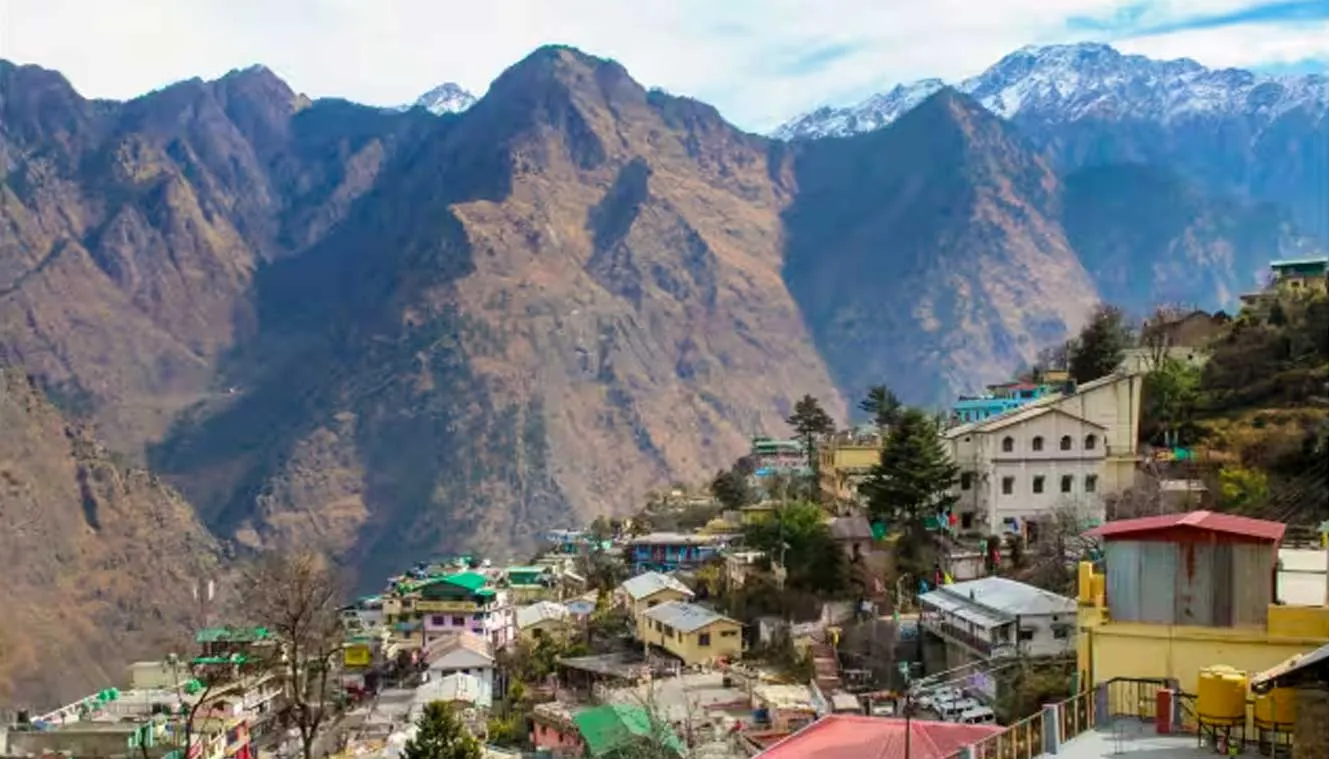
Drive From Pipalkoti To Govindghat - Pulna and Trek to Ghangaria
- Altitude
Pulna: 2100 m/ 6900 ft.
Ghangharia: 3,000 m/ 9,800 ft. - Drive Distance (Pipalkoti to Govindghat): 52 Km | 2 hours.
- Then Dirve Govindghat to Pulna in Local Union Transport 4km in 15min.
- Trek Distance (Pulna to Ghangharia): 9 km | 4 hours.
- Gradual ascent on a stone-paved path, all the way along the river.
- Water is available along the route.
- Hot lunch will be given on the way.
- Mule and porter facilities are available from Pulna.
- BSNL, JIO, and AIRTEL networks are available at Ghangaria.( Erratic network)
- Helicopter service is available from Govind Ghat to Ghangaria and only if the weather allows (Not included in cost).
- Stay in a guest house (Shared Accommodation).
Noteworthy Site: Govinddham Gurduwara, Govindghat; Hemkund Gurduwara base, Ghangharia; Valley of Flowers Information Center; Ghangharia.
Pipalkoti to Govindghat the distance is 52 km. En route, you can spot the final confluence - Vishnuprayag. We will start in the morning after breakfast and reach Govindghat by 8 am and then a 4 km drive to Pulna which is the starting point and included in the trek cost. Then your trek will be 9 km uphill along the river, Pushpawati. The entire trail will be crowded most of the time. Many snack shops selling beverages, hot noodles, omelets with bread, paratha, and the like can be found on this trail. So, you will never go hungry.
The trek will be on a clearly defined stone-paved path, conveniently built with stairs. After a 5 km walk, you will arrive at Bhyundar village. This village marks an amazing viewpoint for clear Hathi Parvat sights. Enjoy the wonderful sight as much as you can, because the strainful steep ascent will commence henceforth. You will reach Gangharia before nightfall, attaining an altitude of 9,800 feet. The stay will be at a guest house.
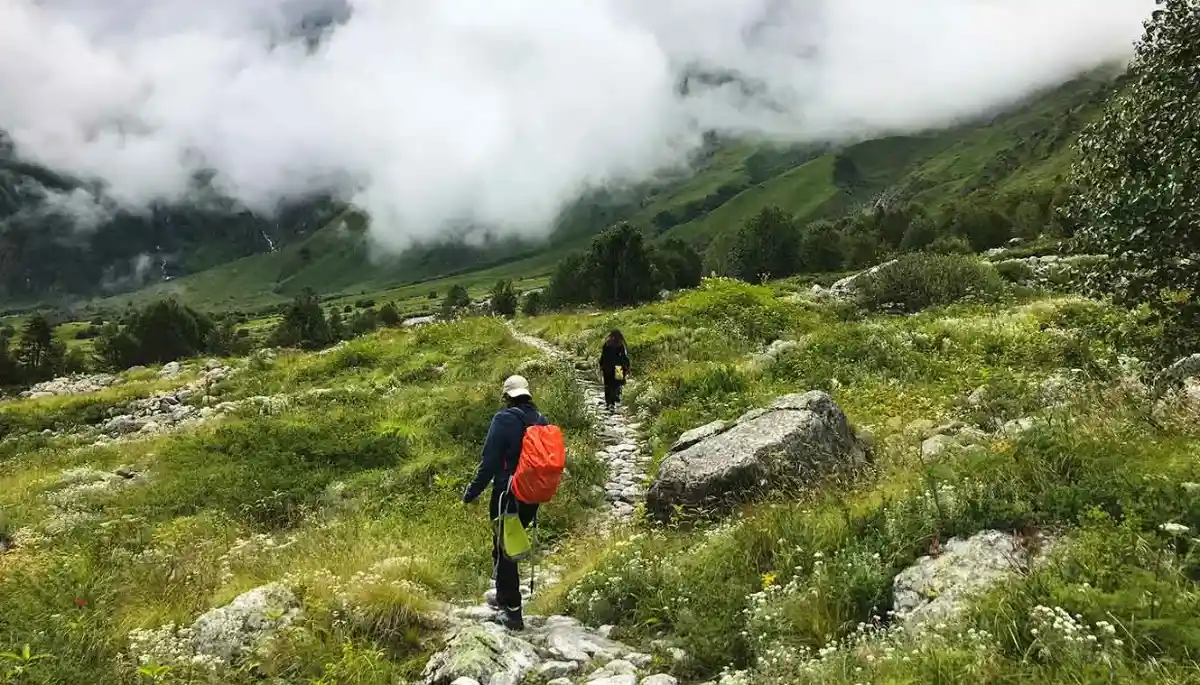
Ghangaria to Valley of Flower and back to Ghangaria
- Altitude: 3,500 m/ 11,500 ft.
- Trek Distance- 4 km, each way | 7hrs.
- The Valley is 6-7 km long and ends with a glacier.
- Mixed incline till the valley followed by a level walk on grassland.
- Can refill water bottles from streams on the way.
- A packed lunch will be given, no food is available in the valley.
- Camping inside the valley is not allowed, can’t stay after sunset.
- Night stay in Guest house (Shared Accommodation).
Prominent flowers: Blue Poppy, Snake Foil, White Leaf Hog Foot, Himalayan Rose, Meadow Geranium, Dog Flower, Hooked Stick Seed, and River Anemone.
The journey to Valley of Flowers is a distance of 4 km. The valley is 6-7 km long; the distance travelled in the valley depends on how the trekkers want to explore the valley. Another, factor to be considered is the stamina of the trekkers.
Right, when you start from Ghangaria in 30 minutes forest check post arrives. The check post might not be an attraction but right before the check post, there is a gushing waterfall called Laxman Waterfall. Another 20 minutes into the greenery and the next furious attraction comes. At this point, the Pushpavati River flows furiously below a wooden bridge. It is quite a common yet unique and mesmerizing capture. The trail is steep and stone paved like the previous day. You can find many bridges and landslide areas when you enter the valley.
The valley is thousand times more stupendous than you might have imagined. It truly makes the Himalayan peaks lively and cherishing. Blue Poppy, Snake Foil, White Leaf Hog Foot, Himalayan Rose, Meadow Geranium, Dog Flower, and Hooked Stick Seed are the native flowers. These astounding colourful blossoms end after a 5 km stretch at a glacier. If the weather is clear the mighty Himalayan peaks of Nilgiri Parvat, Bhyundar Khal, Rattaban, Gauri Parvat, etc. in the background. Today’s journey will conclude with your coming back to Ghangaria before nightfall.
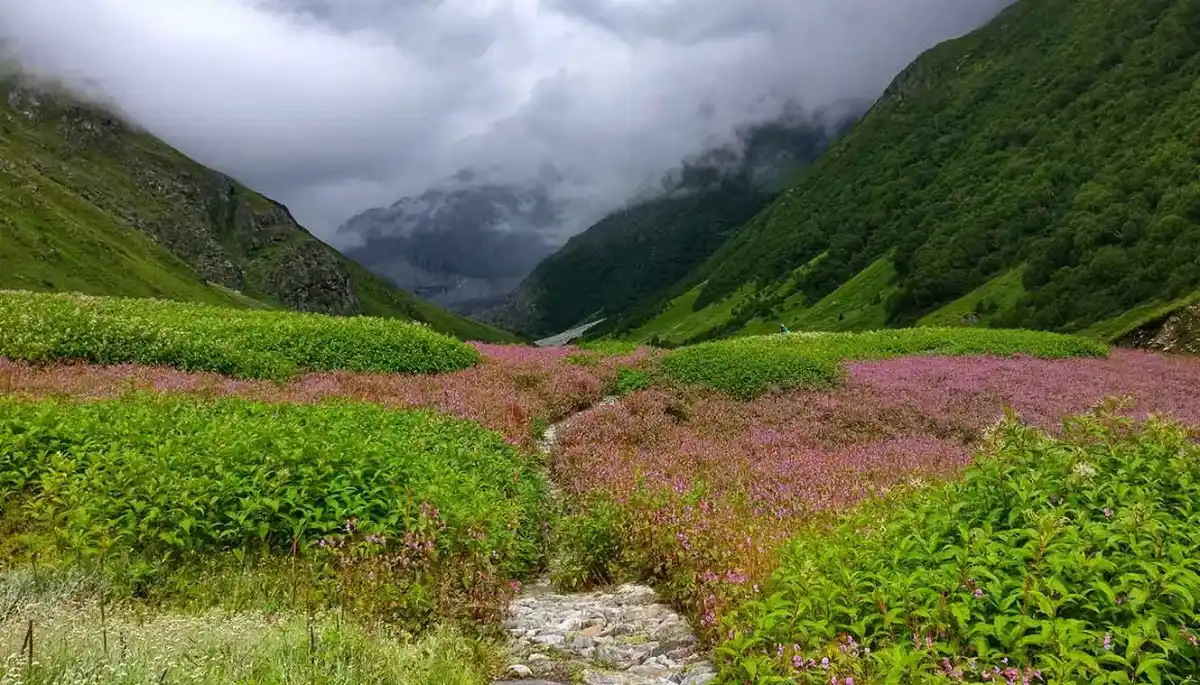
Ghangaria to Hemkund Sahib and back to Ghangaria
- Altitude: 4,300 m/ 14,100 ft.
- Trek Distance: 6 km, each way | 8-9 hours.
- Gradual and steep mixed ascent on a stair-welled stone-paved path.
- Mule ride service is available till Hemkund Sahib.
- Can refill water from roadside dhabas.
- Hot lunch at Gurduwara langar.
- Brahma Kamal, a Himalayan blue poppy can be seen on the way to Hemkund Sahib.
- Night stay in Guest house.
Get ready early in the morning to start trekking (6 Km) for Hemkund Sahib. One of the most revered of all Sikh shrines and the world’s highest Gurudwara, Hemkund Sahib, is situated at an altitude of 4,329 meters. There will be porters and mules if you wish to offload your load. The trail today will be similar to previous days, stone-paved and continuous ascend. There will be shops on the way where you can energize yourself. Watch out for the rare flower Brahmakamal that will be spotted beside pathways.
The Gurudwara is placed magically beside the mirror-like glacial lake Hemkund. During clear skies, one can witness the flawless reflections of the adjoining Saptrishi peaks. The lake is fed by the melting glaciers of Hathi Parvat and Saptrishi peaks. Religious Laxman temple is also found near the lake. In the afternoon trek down to reach Ghangariya for an overnight stay. The evening is free for rest & relaxation.
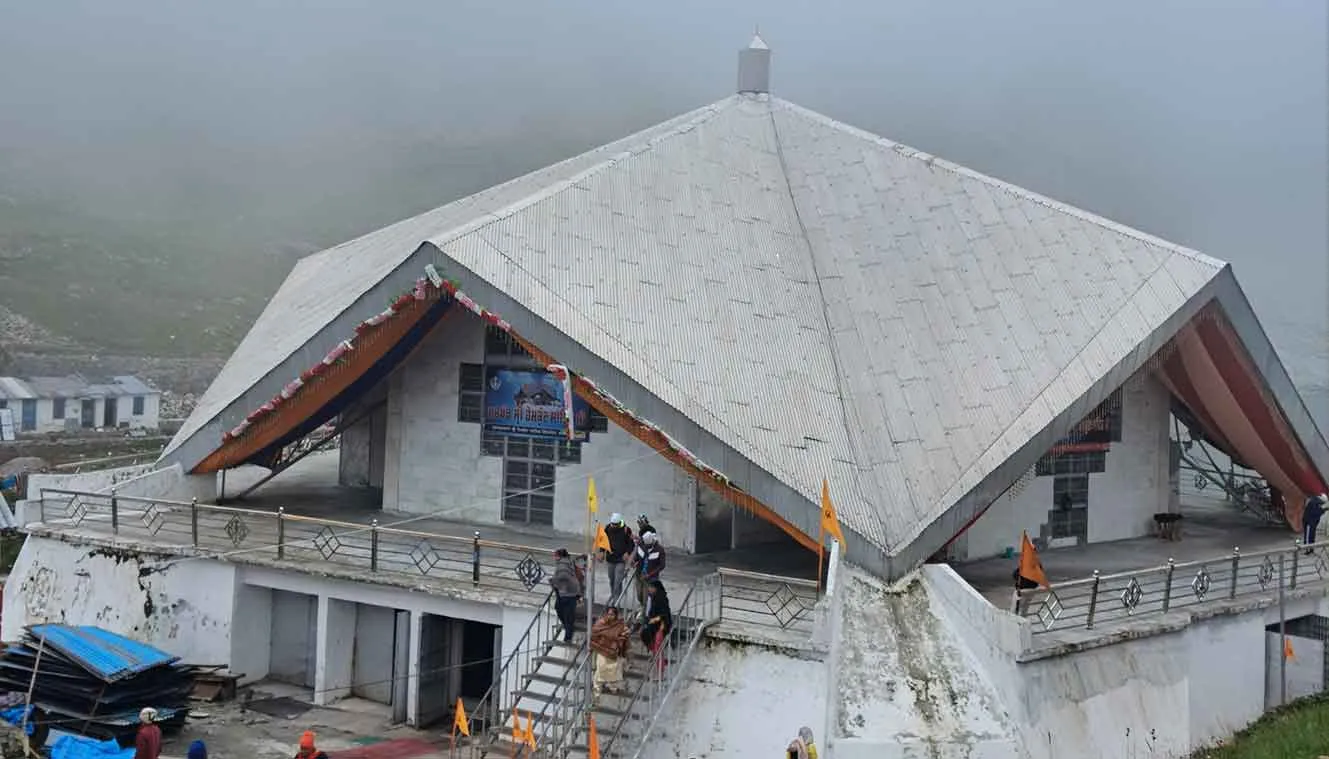
Ghangaria to Govindghat and Drive to Pipalkoti (Badrinath optional)
- Trek Distance (Ghangharia- Pulna): 9 km | 4-5 hrs.
- Drive Distance (Pulna- Govind Ghat): 4km | 15min.
- Drive Distance( Govind Ghat- Badrinath): 25km | 1 hr.
- Drive Distance (Badrinath-Pipalkoti): 75km | 3-4 hrs.
- Packed lunch.
- Guest house stay.
Note:
GovindGhat to Badrinath is a landslide-prone area in monsoon time so if our leaders find that your safety is at risk due to weather conditions/ landslide or road blockage then we shall skip Badrinath altogether and drive to Pipalkoti directly.
After your breakfast in the morning, we descend to Govindghat and then drive to Pipalkoti. From this place, Badrinath is 25 km away and takes 1 hrs to reach. You can visit Badrinath only if road and weather condition permits us.
On arrival, check into the hotel. Overnight stay is arranged in a hotel.
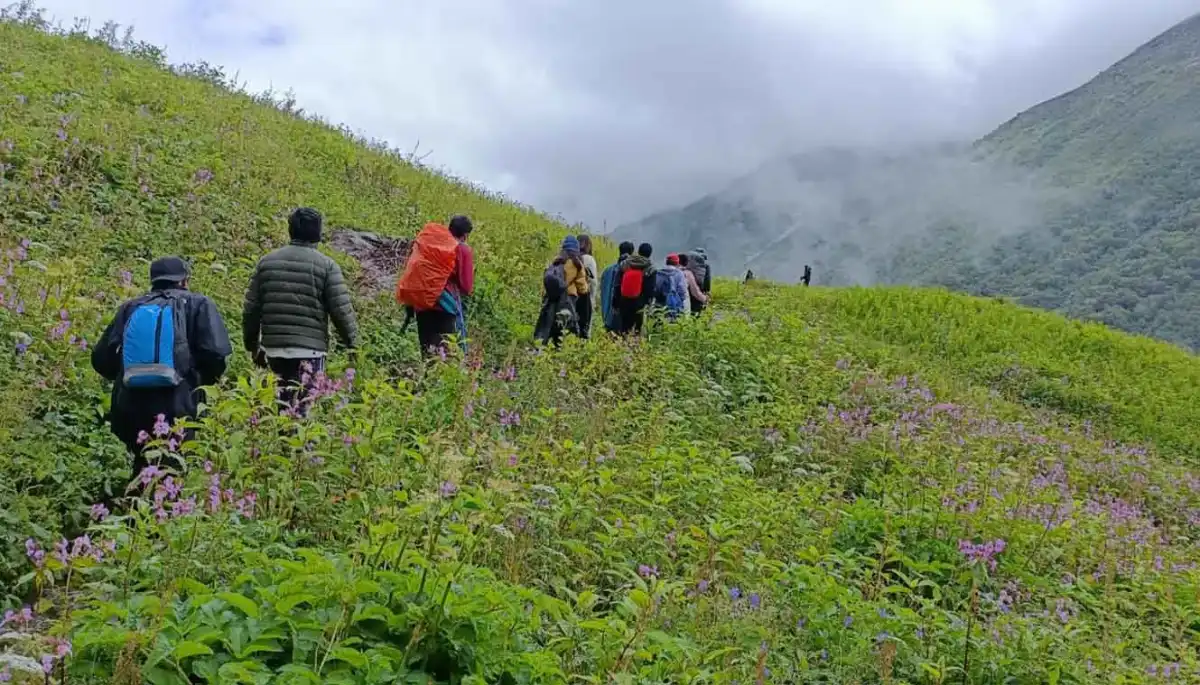
Pipalkoti to Rishikesh
Drive Distance: 200km | 9-10km.
The ride will commence at 6 am and you will reach Rishikesh around 5 - 6 pm. Your Breakfast and Lunch will be on the way at a roadside inn, exclusive of charges, after having your morning tea/coffee you can leave for your next destination.
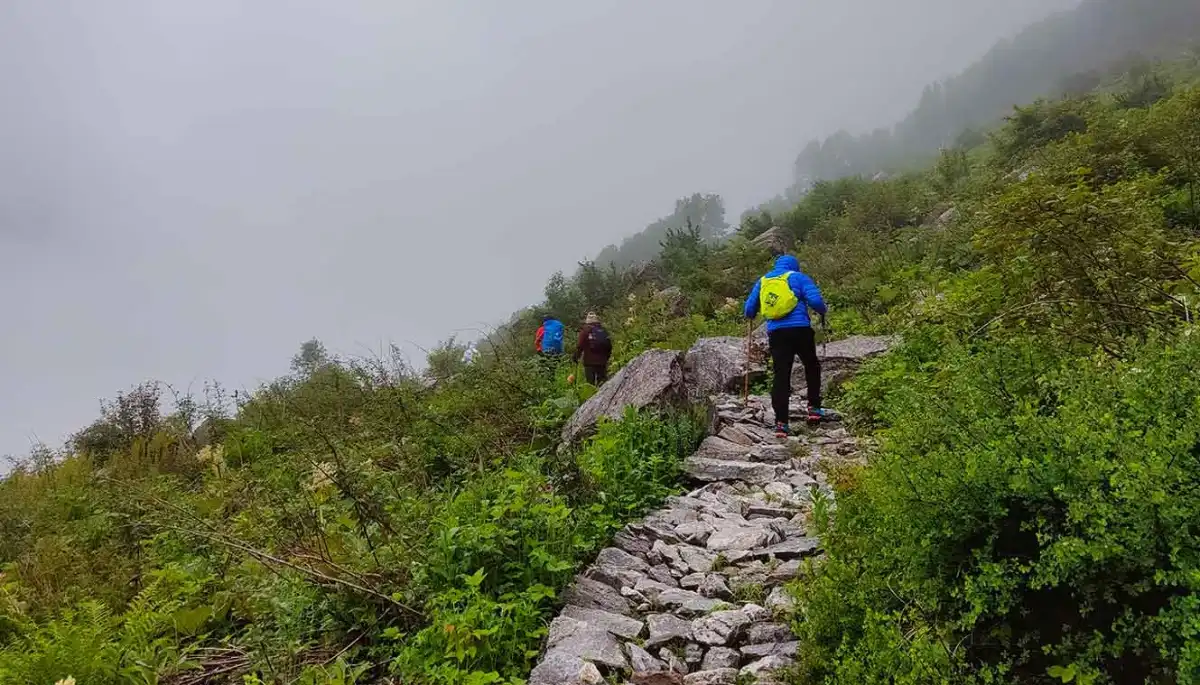
Day-1: Rishikesh to Pipalkoti
- Altitude: 1,340 m/ 4,400 ft.
- Drive Distance: 200 km.
- Driving Time: 9-10 hrs.
Day-2: Drive From Pipalkoti To Govindghat - Pulna and Trek to Ghangaria
- Altitude
Pulna: 2100 m/ 6900 ft.
Ghangharia: 3,000 m/ 9,800 ft. - Drive Distance (Pipalkoti to Govindghat): 52 Km | 2 hours.
- Then Dirve Govindghat to Pulna in Local Union Transport 4km in 15min.
- Trek Distance (Pulna to Ghangharia): 9 km | 4 hours.
Day-3: Ghangaria to Valley of Flower and back to Ghangaria
- Altitude: 3,500 m/ 11,500 ft.
- Trek Distance- 4 km, each way | 7hrs.
Prominent flowers: Blue Poppy, Snake Foil, White Leaf Hog Foot, Himalayan Rose, Meadow Geranium, Dog Flower, Hooked Stick Seed, and River Anemone.
Day-4: Ghangaria to Hemkund Sahib and back to Ghangaria
- Altitude: 4,300 m/ 14,100 ft.
- Trek Distance: 6 km, each way | 8-9 hours.
Day-5: Ghangaria to Govindghat and Drive to Pipalkoti (Badrinath optional)
- Trek Distance (Ghangharia- Pulna): 9 km | 4-5 hrs.
- Drive Distance (Pulna- Govind Ghat): 4km | 15min.
- Drive Distance( Govind Ghat- Badrinath): 25km | 1 hr.
- Drive Distance (Badrinath-Pipalkoti): 75km | 3-4 hrs.
Note:
- GovindGhat to Badrinath is a landslide-prone area in monsoon time so if our leaders find that your safety is at risk due to weather conditions/ landslide or road blockage then we shall skip Badrinath altogether and drive to Pipalkoti directly.
Day-6: Pipalkoti to Rishikesh
- Drive Distance: 200km | 9-10km.
Note:
- Keep a buffer day in your travel plan.
- If buffer day is not used in the travel then it can be used to Explore Rishikesh.
- Read the article Things to do in Rishikesh.
- Distance, Altitude, and Trekking hours are approximate and rounded off.
- Keep the original and copy of ID proof handy.
- Come one day early if planning to come by plane.
Valley of Flowers Trek Graph
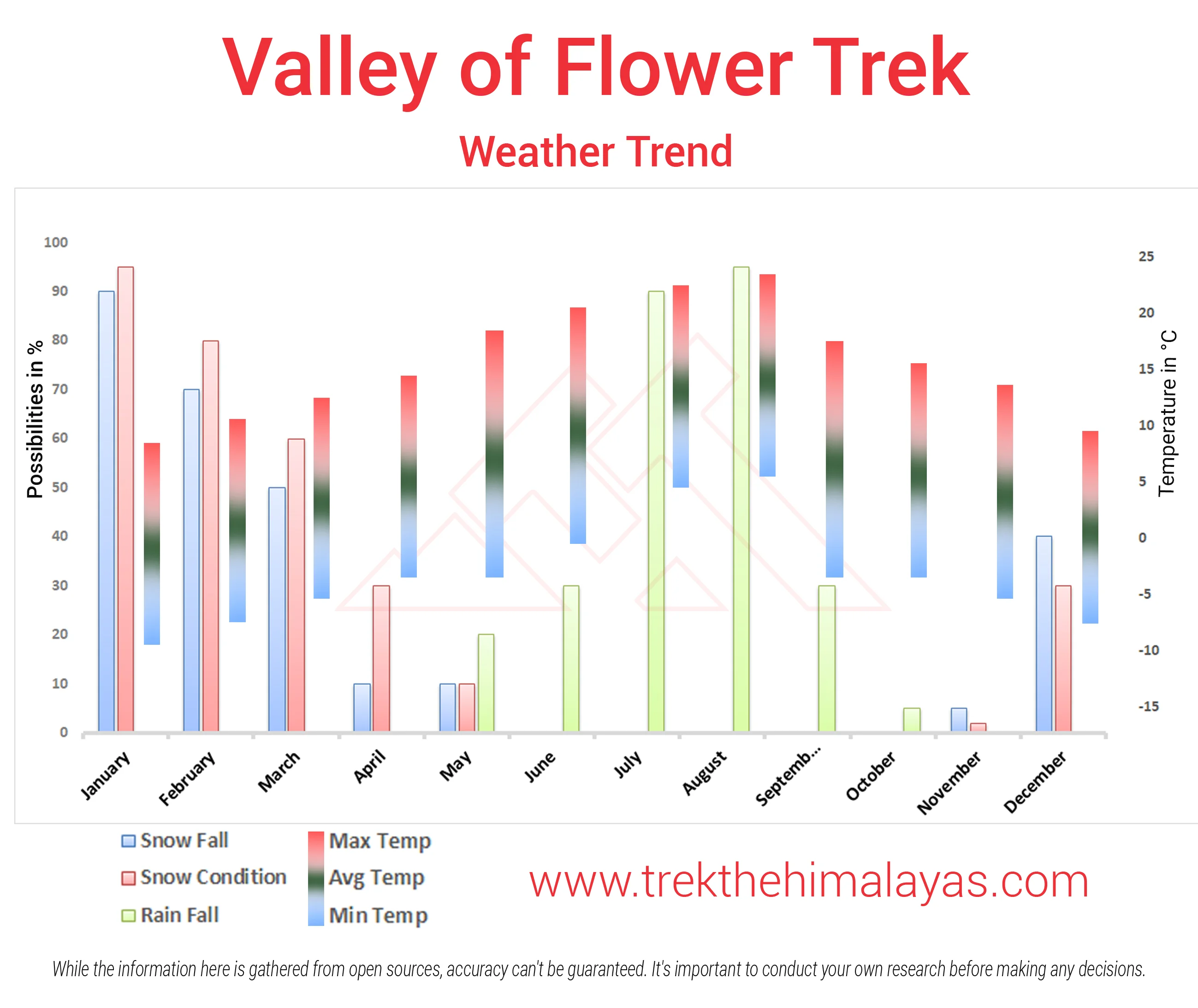
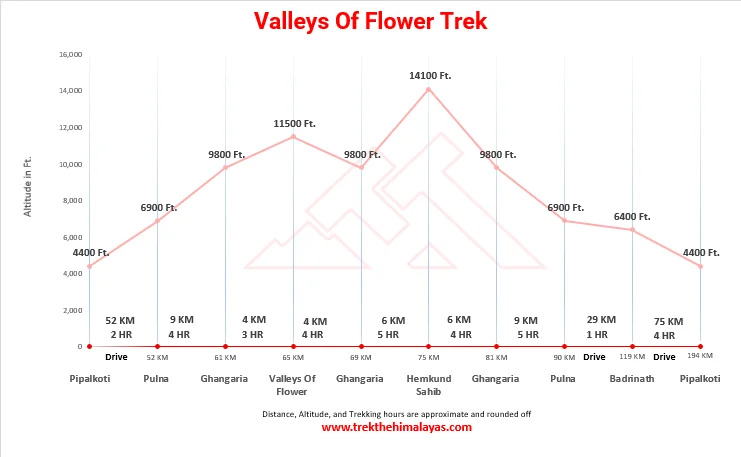
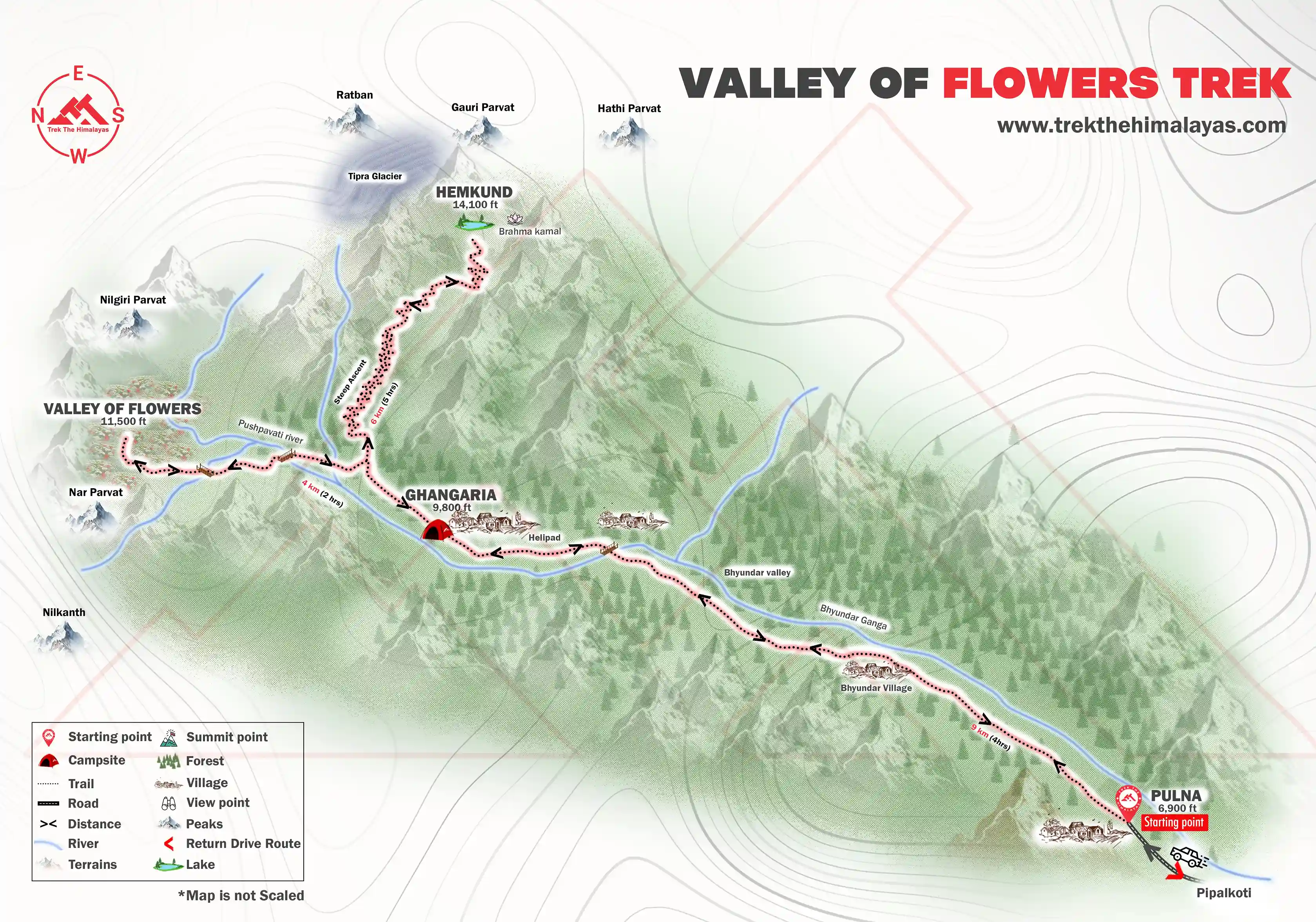
- Pulse rate at rest must be in between (60 to 100 beats per minute).
- Blood Pressure Reading must be in between (DIASTOLIC 75 – 85, SYSTOLIC 100 - 130 mm Hg).
- Respiratory rate at rest must be in between (12 to 20 breaths per minute).
- Should not have Liver and kidney issues.
- Should not have Diabetes Mellitus, Bronchial Asthma, Heart problems, Hypertension, etc.
- No pacemaker implant.
- People with Sinus issues, Epilepsy please contact to trek coordinator before booking the trek.
- If your BMI is not normal, Please contact our Trek coordinator before Trek booking.
Medical & Disclaimer Form (Mandatory Documents) Click here to download Medical & Disclaimer Form
- Government Employees can avail the benefit of Special Casual Leave (SCL) when they join us for a trekking expedition. As per the rules of the Pay Commission, Special Casual Leave can be availed for up to 30 days in a calendar year for trekking/mountaineering expeditions through a registered organization. Trek The Himalayas is a registered adventure tour operator by the Indian Mountaineering Foundation (IMF) and the Ministry Of Tourism (MOT).
- Trekkers have to apply for leave at least 20 days before the trek departure date.
- This service is exclusive to Indian government employees and is applicable only for treks within India.
- Do mail at info@trekthehimalayas to apply and mention your booked trek date and trek name.
- Junior trekkers (below 15 years) should have a company of parents/guardians.
- Trekkers between 15 to 18 years can come solo with the disclaimer form signed by parent/guardian.
- Medical & Disclaimer Form (Mandatory Documents) Click here to download Medical & Disclaimer Form
Important Links
- Mandatory Documents to Bring on A Trek Click Here.
- How to pay Add-ons, Submit Medical Forms, and Dietary Preferences Click Here to watch Video
How To Reach
Pick-Up Information
- It is essential for everyone to arrive at Rishikesh (06:00 am)
- Pick-up Location: Back Stayz, Laxman Jhula, Near SBI Bank, Tapovan, Rishikesh
- Once you have reached Rishikesh, TTH will manage the rest of your travel arrangements, if you have opted for TTH's pick-up service, you can select this option during the booking process by adding it as an add-on.
Options to Reach Rishikesh
First, you can arrive at Delhi, Dehradun airport or Chandigarh. The journey from these locations to Rishikesh is explained below.
1. Take overnight train/bus to Rishikesh.
2. Take overnight train/bus to Haridwar and drive to Rishikesh (25km | 35 min drive with normal traffic).
3. Take overnight train/bus to Dehradun and drive to Rishikesh (50km | 1hr 20min drive with normal traffic).
( We always recommend going for the govt. Buses over the private ones outside the bus station as based on the experience we have found that there are very high chances of delay involved with private buses. Also, govt. Buses are always more reliable. Whichever bus you choose, just make sure to reach Rishikesh at least by 05:30 am. )
4. Board a flight to Dehradun airport (Jolly Grant Airport) (21 km, 30 min). If you're arriving by air, then come one day in advance.
Drop-Off Information
- The designated drop-off point is Tapovan, Rishikesh.
- Reach in Rishikesh by 6:30 to 7:30 pm.
- Please consider planning your subsequent travel arrangements after 10:00 pm.
Note - In July and August month always have a buffer day in your Itinerary due to the Monsoon.
- It's highly advisable to keep a buffer day in your travel plan. If the buffer day is not used, it can be used to explore Rishikesh.
( If you prefer to travel independently to Base camp and don't want to take TTH's pick-up service, you can either take a government bus or book a private cab from Rishikesh. Your trek coordinator will provide guidance on how to arrange for the bus or cab booking. )
- TTH offers comfortable transportation through Tempo Traveler, Bolero, or equivalent vehicles. If you wish to upgrade your mode of transportation, please contact your trek coordinator for further assistance.
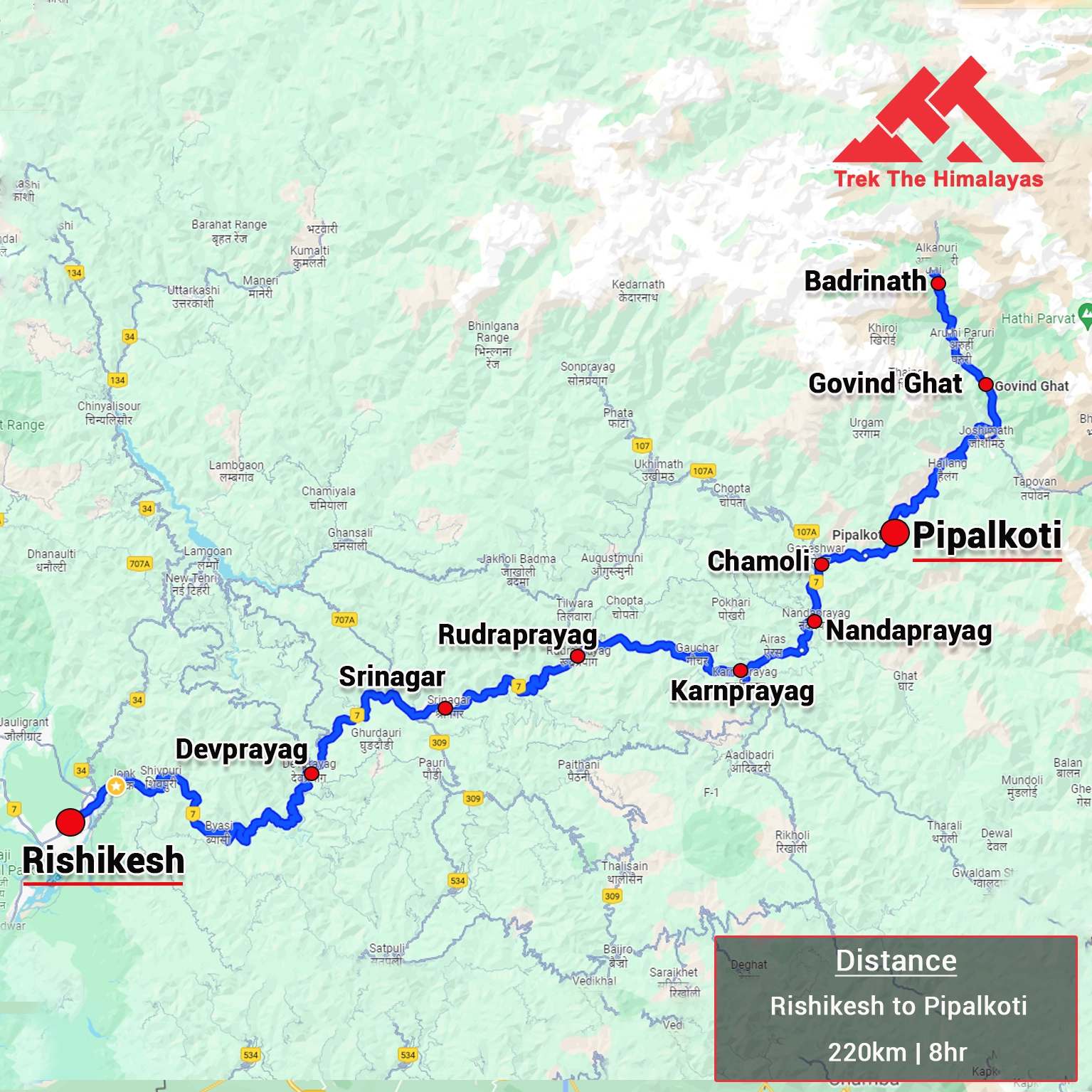
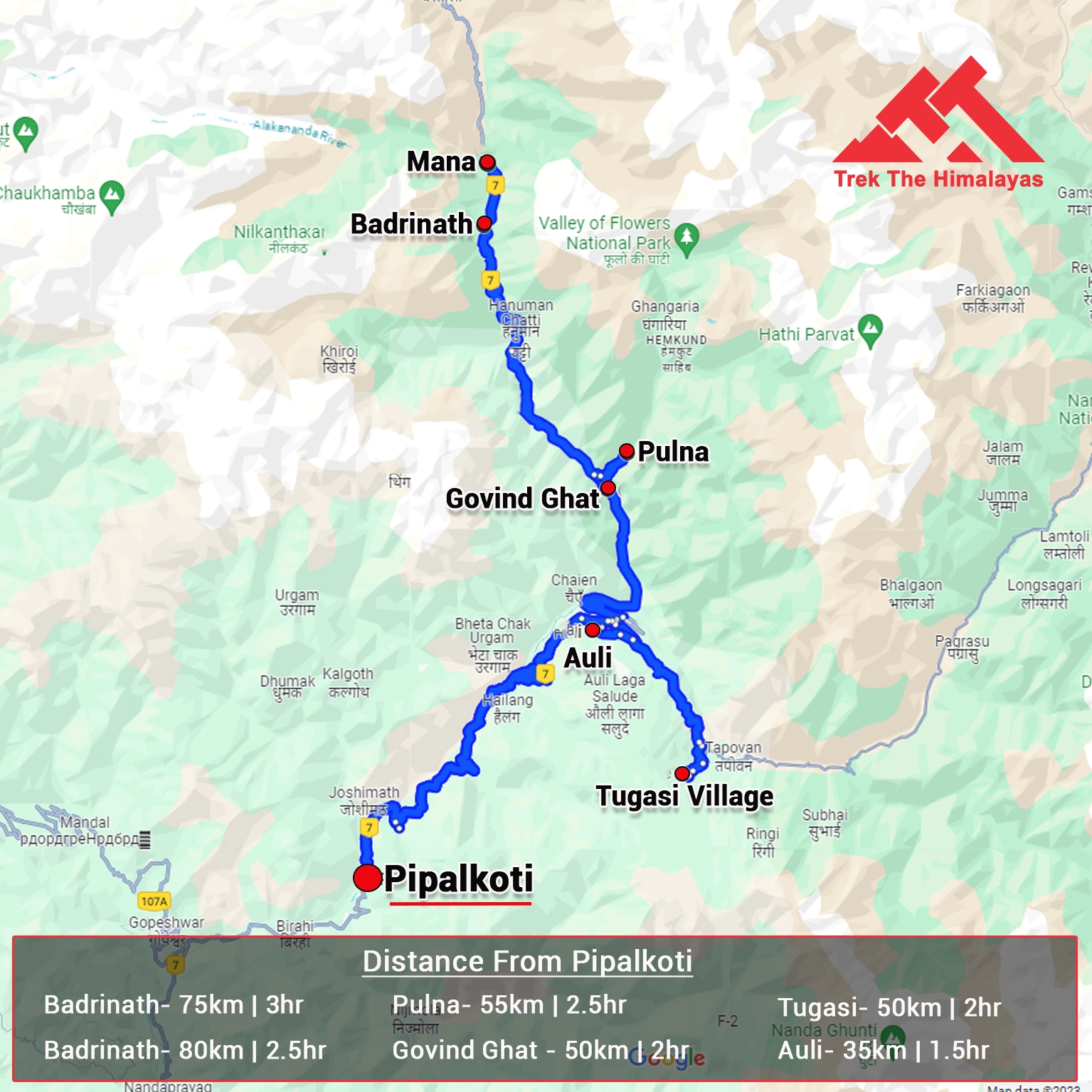
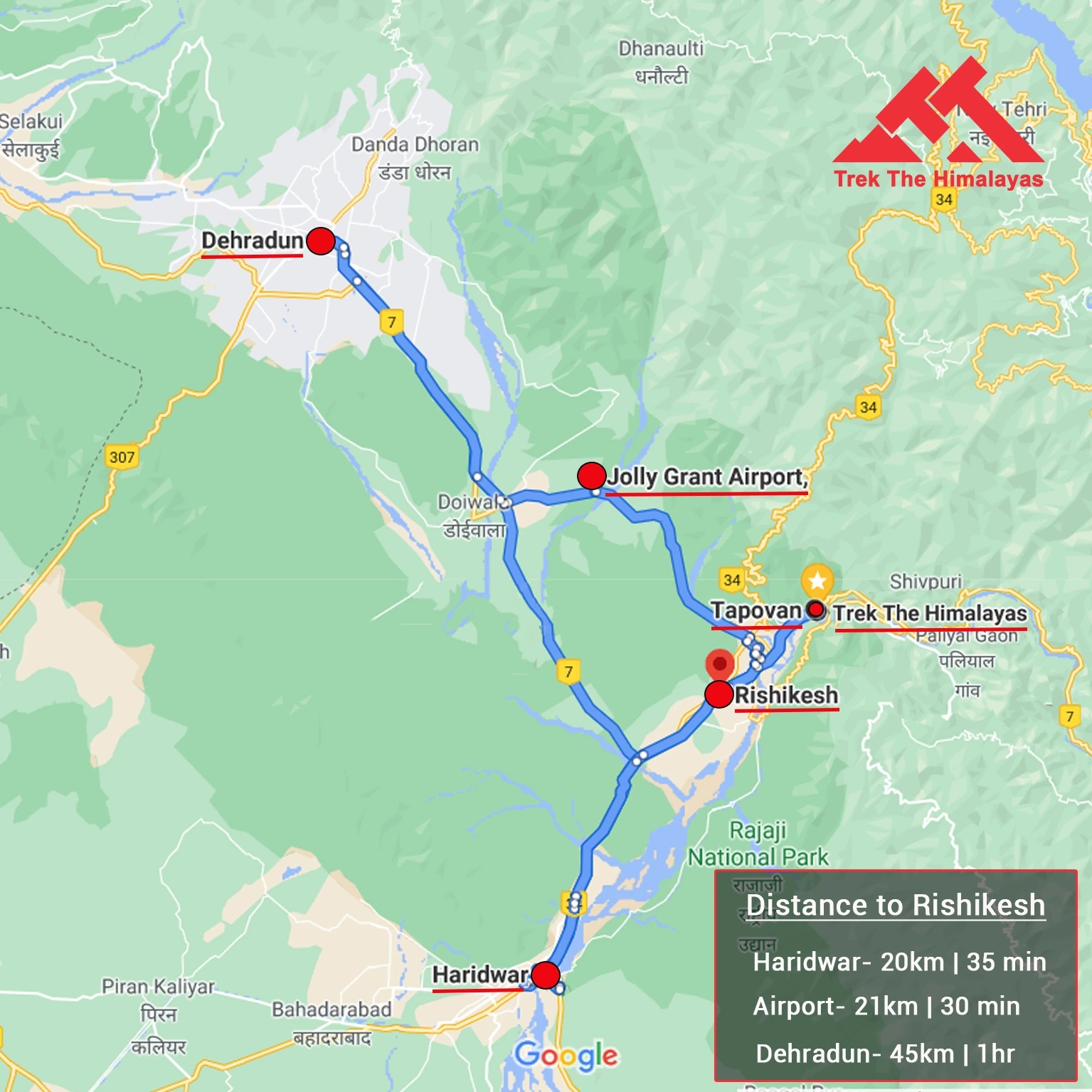
Cost Terms
Valley of Flowers Trek Package Inclusions
1. Accommodation (as per the itinerary):
- Guest house in Pipalkoti(Day 1 and Day 5 as per the itinerary).
- Ghangharia on Day 2, Day 3, and Day 4.
- Triple/quad sharing (separate for males and females throughout the trek)
2. Meals (Veg + Egg):
- All meals (including tea, soup, snacks, etc.) from Day 1 Dinner to Day 5 Dinner. Morning and evening tea, accompanied by light snacks, are included in the Valley of Flowers trekking package.
3. Support:
- 1 Versatile base camp manager handles communication and deploys extra manpower in emergencies.
- 1 Mountaineering & First aid qualified professional trek Leader.
- 1 Experienced high-altitude chef.
- Local experienced guides (Number of guides depending on the group size).
- Enough support staff.
4. Trek equipment:
- Sleeping bag, Sleeping liners (if required), mattresses, and Utensils.
- 3 men all season trekker tent (twin sharing), Kitchen & Dining tent, Toilet tent.
- Camping stool, Walkie talkie.
- Ropes, Helmet, Ice axe, Harness, Gaiters & crampons (if required).
5. First aid:
- Medical kit,Stretcher,Oxygen cylinder,Blood pressure monitor,Oximeter,Stethoscope.
6. Transportation (as per the itinerary):
- Transport from Rishikesh to Pipalkoti and return ( If opted from TTH).
- Transport Pipalkoti to Govindghat, Pulna & Badrinath and return as per the itinerary ( If opted from TTH).
7. Mules/porters to carry the central luggage.
8. Cloakroom facility available at the base camp for additional luggage
9. All necessary permits and entry fees, Upto the amount charged for Indian
10. Trek Completion Certificate.
Valley of Flowers Trek Package Exclusion
- Insurance (Mandatory).
- Food during the transit.
- Any kind of personal expenses.
- Mule or porter to carry personal luggage.
- Emergency evacuation, hospitalization charge, etc.
- Anything not specifically mentioned under the head Inclusion.
Things can be provided on demand and availability (participant has to pay extra for these things).
1- Satellite phone/set phone - is a type of mobile phone that connects via radio links via satellites orbiting the Earth instead of terrestrial cell sites like cellphones. Therefore, they can operate in most geographic locations on the Earth's surface.
2- Gamow/PAC HAPO Bag(Portable Hyperbaric Bag) - is a unique, portable hyperbaric chamber for the treatment of acute mountain sickness (AMS), also known as altitude sickness.
3- AEDs (Automated External Defibrillators) are portable life-saving devices designed to treat people experiencing sudden cardiac arrest, a medical condition in which the heart stops beating suddenly and unexpectedly.
Cancellation Terms
To request a cancellation, please email us at info@trekthehimalayas.com using your registered email ID.
Cancellations prior to 25 days from the start of the Trip
Refund Options
- 5% deduction of trek fee
- 100% cash voucher for any trip till one year
- Transfer your trek (any trek, any date) to your friend
Cancellation between 24 days and 15 days to the start of the Trip
Refund Options
- 30% deduction of trek fee
- 100% cash voucher for same trip till one year
- 85% cash voucher for any trip till one year
- Transfer your trek (same trek, any date) to your friend
Cancellation between 14 days and 10 days to the start of the Trip
Refund Options
- 50% deduction of trek fee
- 80% cash voucher for same trip till one year
- 70% cash voucher for any trip till one year
- Book the same trek, in the same season, with any other batch
- Transfer your trek (same trek, any date) to your friend
Cancellation less than 9 days to the start of the trek.
Refund Options
- No cash refund
- 20% cash voucher for the same trip till one year
- 10% cash voucher for any trip till one year
- Transfer your trek (same trek, same date) to your friend
Cancellation Policy (Emergency Cases):
In case of a death in the immediate family (parents, siblings, spouse, children) or if the trekker is hospitalized (min. 48 hours) or suffers a fracture (leg/arm) within a week before the trek, even if canceled a day before:
90% refund in cash & 10% as a voucher (valid for 1 year, for any India trek)
Valid documents required. We’re here to support you during tough times.
Note- If a booking is made using a voucher or discount code, the policies related to vouchers and discounts cannot be modified.
In the unlikely event that TTH cancels a trek prior to the scheduled departure date:
While it is extremely rare for TTH to cancel a trek, we understand that unforeseen circumstances or natural disasters may occasionally require us to do so before the scheduled departure. These circumstances could include continuous rain or snow, thunderstorms, snowstorms, landslides, floods, earthquakes, or any other natural calamity that poses a risk to the safety of our trekkers. Additionally, unforeseeable events such as local riots, curfews, pandemics, lockdowns, government orders, or any similar situations that compromise the safety of the trekking experience may also necessitate a cancellation.
In the event of such a cancellation, TTH will provide you with a voucher equivalent to the amount you paid for the trek. This voucher can be redeemed for any of our treks within the next year, allowing you to still enjoy an adventure with us at a later date.
Note
-
The issuance of a voucher is not applicable in situations where you are required to descend from the trek for any reason. The trek leader may make the decision to send you down from the trek due to factors such as insufficient fitness level, symptoms of Acute Mountain Sickness (AMS), high blood pressure, exceeding the designated turn-around-time, health concerns, or if you are found smoking, drinking, or violating the rules set for the trek. In such cases, the provision of a voucher does not apply.
In the Rare Event that TTH Shifts a Trek
We would like to emphasize that weather conditions in high-altitude areas are highly unpredictable and can undergo sudden changes at any time, irrespective of the day. Additionally, circumstances beyond our control, such as natural disasters, political unrest, pandemics, and lockdowns, may impact the feasibility of conducting a trek. In cases where we are unable to proceed with an event due to such circumstances that are beyond our direct control, we will make every effort to provide you with an alternative trek that is safer and more suitable.
In such situations, we will issue a voucher to offset the cost difference between the originally scheduled trek and the alternative trek. This voucher can be redeemed at any time within one year from the date of issue. Please note that a refund fee or reimbursement of the cost difference is not applicable in these cases.
Note:
- Change of trek batch is dependent on the availability of seats in the batch
- In case of transferring a trek to a friend, he/she should satisfy all the mandatory requirements put forward by TTH
- TTH holds the right to change/cancel the policies, without prior notice
- Cash refund is applicable only in case of bookings made without using any promotional offer code or vouchers
Cash Voucher Terms
- This is a non-transferable voucher
- The voucher cannot be merged with any other offer of Trek The Himalayas
- The voucher is valid for Trek booked directly with Trek The Himalayas in India
- To avail the voucher please use your register phone number or e-mail id
- All the other Terms of booking a trek with Trek The Himalayas are applicable to the voucher
- Trek The Himalayas holds rights to add/remove any of the Terms and Conditions without prior notice
In the event that your entire group is compelled to abandon the trek after reaching the destination pick-up place, due to reasons such as extreme weather, trail disruption, roadblocks, withdrawal of government permissions, or any other unforeseen circumstances—no cash refund or voucher will be provided. However, most of our treks are covered under our Trek Again Policy, allowing you the opportunity to repeat the same trek at a later date.
Itineraries are based on information available at the time of planning and are subject to change. "Trek The Himalayas" reserves the right to change expedition dates, people or itineraries as conditions warrant. If a trip must be delayed or the itinerary changed due to bad weather, road conditions, transportation delays, government intervention, airline schedules, sickness, or other contingency for which TTH or its agents cannot make provision, the cost of delays and/or other changes are the responsibility of the participant. TTH reserves the right to decline, or accept, any individual as a trip member for any reason whatsoever.
Trek Essentials
Rent EquipmentPDF Of Trek Essential Download
| Backpack with rain cover | (50 - 60 ltr) with comfortable shoulder straps |
| Day pack with rain cover | 20 - 30 ltr (If off-load opted) |
| Walking stick | Advisable (At least one) |
| Water Bottle / Hydration pack | 2 bottles of one liter each, People who use hydration pack 1 hydration pack and 1 bottle of one liter. |
| Small size tiffin/lunch box | 1 Nos |
| Snacks | Energy bars, dry fruits, electral/ors |
| Personal Medical Kit | Consult your doctor |
| T-Shirt (Synthetic quick dry) | 2 Full & 2 Half sleeves |
| Fleece T-shirt | 1 Nos |
| Wind stopper / Fleece jacket | 1 Nos |
| Windproof Jacket | 1 Nos |
| Down feather / Hollow jacket | 1 Nos |
| Thermal inner (Upper and Lower) | 1 Pair |
| Trek Pant (Synthetic quick dry) | 3 Nos |
| Wind stopper / Fleece Pant | Not required |
| Waterproof gloves | Not required |
| Fleece / woollen gloves | 1 Pair |
| Poncho / waterproof Jacket and pant | 1 Nos |
| Sunscreen | 1 Nos |
| Moisturiser | 1 Nos |
| Chap-stick / Lip balm | 1 Nos |
| Toothbrush and toothpaste | 1 Nos |
| Toilet paper & Wipes | 1 Nos |
| Soap / hand sanitizers | 1 Nos |
| Antibacterial powder | 1 Nos |
| Quick dry towel | 1 Nos |
| Head torch | 1 Nos. (Avoid Hand torch) |
| Sun Cap | Not required |
| Woolen cap | 1 Nos. |
| Balaclava | Not required |
| Buff / Neck-gaiters | 2 Synthetic |
| Sunglasses | UV with dark side cover, People who wear spectacles - (A)- Use contact lenses | (B)- Photo chromatic glasses |
| Trekking shoes | 1 Pair (Waterproof, high ankle, good grip) |
| Floaters / flip-flops | 1 Pair |
| Cotton socks | 7 pairs |
| Woollen socks | 1 pairs |
| Gaiters | 1 Pair (TTH provides when required) |
| Micro spikes | 1 Pair (TTH provides when required) |

Frequently Asked Questions(FAQ)
To register with TTH, visit our website - www.trekthehimalayas.com and create your account. To create your account you will need to use your email address and fill in all the details, set your unique password and your account is ready to use.
- To book a trek with TTH, you first need to register with us and create an account.
- Choose the trek that you want to do and click on available dates.
- You will land at the login page, fill in the required details.
- Add Participants, choose add-on services click on the Pay now button, choose your preferred payment method, and make the payment. TTH accepts multiple payment options, including credit/debit cards, net banking, and UPI.
- You will receive a confirmation email from TTH with all the necessary details about the trek, including the meeting point, transportation, accommodation, and other important instructions.
- Click Here to watch Video
please send an email to us at info@trekthehimalayas.com or reach out to the numbers provided in the Help and Support section of your Trek Page. We will ensure that your issue is promptly resolved.
To book services such as off-load luggage and transportation, you can find them listed as add-ons. These additional services can be booked at the time of your initial booking. If you miss booking add-ons during the initial reservation, you can log in anytime and easily book 4 days before the departure date add-ons through the platform.
If you have booked the wrong trek or selected the wrong date, don’t worry! You can contact us at +91 9368882322 (Monday to Saturday, 10 AM to 10 PM) or email us at info@trekthehimalayas.com. You can also discuss this with your trek coordinator. Please make sure to inform us at least 10 days before the departure of your trek. Only then can we help you reschedule or arrange another trek for you.
We recommend visiting our "Suggest Me a Trek" page. By filling out the form, our experts will contact you with the best possible trek options based on your preferences and experience level. Alternatively, you can reach out to us via email at info@trekthehimalayas.com or give us a call using the numbers provided on our website for personalized assistance and recommendations.
Family treks differ from regular treks by focusing on ease of difficulty, offering shorter durations for younger participants, Kid-friendly and easily digestible foods, child-friendly activities, maintaining a higher guide ratio for diverse age groups, and implementing additional safety measures for families.
Family Trek with Kids recommendation Only Dayara Bugyal and Chopta Chandrashila Trek.
Minimum age for TTH treks is typically 7 years, though this may vary depending on the specific trek.
Yes, you can take a kids to a high-altitude trek with a parent. Discuss with a trek expert before booking a trek.
- Junior trekkers (below 15 years) should have a company of parents/guardians.
- Trekkers between 15 to 18 years can come solo with the disclaimer form signed by parent/guardian.
- Medical & Disclaimer Form (Mandatory Documents) Click here to download medical and disclaimer form
Physical Fitness: Ensure your child is physically fit. Engage them in regular exercise, outdoor activities, and hikes to build stamina and endurance. Hydration: Emphasize the importance of staying hydrated at high altitudes. Encourage your child to drink water regularly, even if they don't feel thirsty. Proper Nutrition: Provide a well-balanced diet with sufficient carbohydrates for energy and foods rich in iron to prevent altitude sickness. Adequate Sleep: Ensure your child gets enough sleep in the days leading up to the trek. Quality rest is crucial for altitude adaptation. Educate on Altitude Sickness: Teach your child about the symptoms of altitude sickness, such as headache, nausea, and dizziness. Encourage them to communicate any discomfort immediately. Appropriate Clothing and Gear: Dress your child in layers to adjust to changing temperatures. Ensure they have appropriate trekking gear, including sturdy footwear. Positive Mindset: Foster a positive mindset. Encourage your child, and let them know it's okay to take breaks when needed. Medical Check-Up: Schedule a medical check-up before the trek to ensure your child is fit for high-altitude activities. Consult with a healthcare professional about any potential health concerns.
TTH takes special care to provide wholesome and nutritious food for children on treks. Here are some of the foods that are typically served for children:
Breakfast: For breakfast, TTH serves a variety of options like porridge, cornflakes, bread, butter, jam, honey, boiled eggs, omelettes, and pancakes. Children can choose from these options to fuel themselves for the day's trek.
Lunch: For lunch, TTH serves lunch which includes rotis, vegetables, rice, dal, and salad. The rotis are usually made fresh on the trek and are a good source of carbohydrates. The dal and vegetables provide protein and other essential nutrients.
Snacks: TTH provides healthy snacks like fresh fruits, dry fruits, energy bars, cookies, and biscuits to keep the children energized throughout the day.
Dinner: For dinner, TTH serves a hot and wholesome meal which includes soup, rice, dal, vegetables, and a non-vegetarian dish (if requested in advance). Children can also choose from a variety of desserts like custard, jelly, and fruit salad.
Dietary requirements: If a child has any special dietary requirements, TTH can cater to those needs as well. For example, if a child is lactose intolerant or allergic to nuts, the kitchen staff can make arrangements to accommodate those requirements.
Choosing the right trek for a beginner can be a bit overwhelming as there are many factors to consider such as distance, elevation gain, terrain difficulty, weather, and time of year. Here are some tips that can help you choose the right trek for a beginner:
1. Determine fitness level: Assess the fitness level of the beginner to understand their physical capabilities. This will help you select a trek that is challenging but not too difficult.
2. Choose a well-traveled trail: A well-traveled trail will have more amenities such as signposts, water stations, and shelter. It is also safer as there will be other hikers on the trail.
3. Consider the length of the trek: For beginners, it is recommended to start with a shorter trek that can be completed in a day or two. This will help them get acclimatized to trekking and build their confidence.
4. Look for gradual elevation gain: Choose a trek with a gradual elevation gain rather than steep ascents. This will make the trek easier and more enjoyable.
5. Check the weather: Check the weather forecast before selecting a trek. Avoid treks during the monsoon season or winter when the trails can be slippery or dangerous.
6. Research the trail: Read about the trail to get an idea of the terrain, altitude, and difficulty level. This will help you select a trek that is suitable for the beginner.
7. Consult with an expert: If you are unsure about which trek to choose, consult our trek expert Mr. Nitin (+91 70600 59773) between 10 AM to 6 PM (Tuesday - Friday). Mr. Nitin will provide you valuable advice and guidance.
Overall, it is important to choose a trek that is enjoyable, challenging but not too difficult, and suitable for the beginner's fitness level and experience.
It is not recommended for a beginner to choose a difficult Himalayan trek. Trekking in the Himalayas can be physically and mentally challenging, especially if you are not used to the high altitude, steep slopes, and rugged terrain. Choosing a difficult trek without the proper experience, fitness level, and preparation can be dangerous and put you at risk of altitude sickness, injury, and other hazards.
If you are a beginner, it is recommended to start with an easier trek and gradually build up your skills and experience. This will help you understand the challenges of trekking in the Himalayas, and also prepare you physically and mentally for a more difficult trek in the future. It is also important to choose a trek that matches your fitness level, experience, and interest.
There is no specific age limit for a beginner trekker. However, it is important to consider your physical fitness, health condition, and personal interests before embarking on a trek. Trekking in the Himalayas can be physically and mentally demanding, and requires a certain level of physical fitness and endurance.
If you have any pre-existing medical conditions or are above a certain age, it is recommended to consult with a doctor before embarking on a trek. It is also important to listen to your body and take breaks as needed during the trek to prevent exhaustion or injury.
We recommend visiting our "Suggest Me a Trek" page. By filling out the form, our experts will contact you with the best possible trek options based on your preferences and experience level. Alternatively, you can reach out to us via email at info@trekthehimalayas.com or give us a call using the numbers provided on our website for personalized assistance and recommendations.
Yes, you can join the trek. We have fixed departure groups where you can simply book your trek and we will take care of curating a group.
Before you start the trek, it is recommended that you make all the necessary phone calls as during the trek you may or may not receive network coverage, once you come back to the Base Camp, you can reconnect with your family via phone once again. You can share your trek coordinator contact detail with your family members to get the latest updates about your trek batch.
At TTH, we provide wholesome and nutritious meals during the trek. The food is vegetarian and includes a variety of dishes such as rice, dal, vegetables, chapati, paratha, pasta, noodles, and soup. We also offer snacks such as biscuits, and salty, and dry fruits during the trek. Special dietary requirements such as vegan, gluten-free, or Jain food can also be arranged if informed in advance.
If you are allergic to some foods, you need to let us know in advance so that we can make arrangements accordingly.
TTH is a trekking company that prioritizes the safety of all its participants, including women trekkers. We have a comprehensive safety system in place, which includes a dedicated team of experienced and trained trek leaders and support staff who are equipped to handle emergency situations and provide first aid.
TTH also takes specific measures to ensure the safety and comfort of women trekkers. They have a separate tent accommodation for women trekkers, female trek leaders, and support staff. They also provide separate toilet facilities for women and encourage a safe and respectful environment for all trekkers.
Moreover, TTH has a strict policy against any kind of harassment and has a zero-tolerance policy towards such incidents. They have a designated Internal Complaints Committee (ICC) to investigate and address any complaints related to harassment or misconduct. Overall, TTH has a good reputation for safety and responsible trekking practices, and women can feel comfortable and safe while trekking with them.
In case you are the only women in the group, we provide a single sleeping arrangement. Also, during the trek, the trek leader will always remain by your side to provide optimum safety and reassurance.
You can reach out to the trek coordinator to inquire about the number of female trekkers and their respective states who have booked the trek. Please note that the trek coordinator cannot disclose personal details of any trekker. Once you've confirmed your booking, a WhatsApp Group will be created for all the trekkers in your batch. This allows you to connect with fellow trekkers before the trek begins.
While many of our treks are led by female trek leaders, however, it is not possible to know which trek leader is assigned to which group. But nonetheless, whether the trek leader is male or female you can be completely assured of your safety and security with us.
Yes, it is possible to trek with periods. However, it is important to take some extra precautions and preparations to ensure a comfortable and safe trekking experience. Here are some tips that can help you trek during your period:
1. Use menstrual hygiene products that you are comfortable with, such as tampons, pads, or menstrual cups. It is recommended to carry enough supplies for the entire duration of the trek.
2. Pack wet wipes, hand sanitizer, and plastic bags to dispose of used hygiene products.
3. Wear comfortable and breathable clothing that allows for easy movement and reduces friction. Avoid wearing tight or restrictive clothing that can cause discomfort.
4. Carry pain relief medication, such as ibuprofen or acetaminophen, in case of menstrual cramps.
5. Stay hydrated and maintain a balanced diet to support your energy levels and overall health.
6. Take breaks as needed and listen to your body. If you feel uncomfortable or experience any unusual symptoms, seek medical attention immediately. It is also recommended to consult with a doctor before going on a trek during your period, especially if you have a pre-existing medical condition or are taking medication.
By taking necessary precautions and being prepared, you can have a safe and comfortable trekking experience even during your period. We provide proper disposal facilities for sanitary pad disposal during the trek.
We offer three person tents with twin-sharing for optimum comfort. A woman trekker will share a tent with another woman trekker and if you are the only woman in the group, you will be given a single accommodation for your comfort and privacy.
Yes, we do provide gears on rent. You can book it using you TTH account directly.
Mountaineering qualified Experienced and first aid certified Trek Leader, First Aid Certify local guide, Cook, helpers and supporting staff.
People suffering from Bronchitis, Asthma, High blood pressure, Epilepsy (got faints), TB , Heart problem or on higher BMI side are strictly not allowed to go on any Himalayan trek. Apart from this if you had any medical history, please let us know.
No. Alcohol and smoking isn’t allowed while on trek. It is totally misconception that it will keep you warm. Your body need to acclimatize properly and for that eat properly and drink enough water; these things will keep you warm.
Toilet tents provide a convenient solution for answering nature's call in the great outdoors. Dry toilets, in particular, offer a highly sanitary approach. By digging a pit and utilizing mud and a shovel, you can easily cover up your waste. This method ensures cleanliness and hygiene while camping or exploring in the forest.
Remember to pack essential toiletries to complete your outdoor bathroom kit and maintain proper personal hygiene during your adventures. With these practices in place, you can enjoy nature while also respecting it.
Layer Up From Head To Toe
Eat Full Meals, never sleep empty stomach
You can keep warmee (if you’re more susceptible to cold).
Use sleeping bag in right way and don’t leave free space in sleeping bag.
For upper body
– Thermal layer
– T-shirt (full-sleeves)
– Fleece T-shirt (for extreme colds)
– Fleece layer
– Thick Jacket/Down Jacket
– Waterproof or Windproof layer (outermost layer, when it is snowing or raining)
- For Lower Body
– Thermal layer
– Hiking pants (normal) or Winter hiking pants
Based on how warm you feel you can skip any of the above layers. Your outer later should be windproof since it is windy at high altitude.
The idea behind layering is that the more insulation you have the less cold you feel, and instead of wearing a very thick jacket if you wear multiple layers, your body will be better insulated against the cold.
Yes, we provide micro spikes and gaiters, if required.
Mandatory documents: 2 xerox of ID having address (addhar card/driving license), 2 Passport size photographs, hard copy Medical form signed & sealed by doctor, disclaimer form sign by trekker and high altitude insurance.
No. We don’t but we can suggest you good hotel/Stay nearby pick up location.
Yes, trekker must carry 2 water bottles 1 litre each so they can refill it at campsite for drinking and keep themselves hydrate.
You should buy shoes which has these three features –Good grip, Ankle Support and additional water resistant layers. Generally, we advise Quechua Trek 100, MH 500 and MH 100.
No one is forced to go on. There is always enough staff to split the party according to need and regroup later at the camp. Most people have no trouble reaching the highest campsite. If some members decide not to climb the final distance they can wait for the climbers to come back down the same way or take a lateral path to the descent route.
Trek The Himalayas is the safest and most trusted trekking organization in India. Our deep expertise and commitment ensure that each trekker can fully immerse in the Himalayan beauty while experiencing a well-organized and memorable journey. We are proud to be recognized among the best trekking companies in India and have been awarded the PHD Samman Award two years consecutively for Best Adventure Tour Operator. Our founders, themselves are proficient mountaineers and belong to the hilly states of India. At TTH we follow all the safety protocols. Our Trek Leaders are expertly trained in First Aid and Acute Mountain Sickness (AMS) management. The extensive experience is a key factor in establishing us as the best trekking company in India.
Explore the best trekking companies in India and see what sets them apart.Yes, Trek The Himalayas (TTH) provides customized trekking packages, and premium trek packages, apart from fixed departures tailored to your preferences and needs. We understand that each trekker has unique interests, timeframes, and fitness levels, so we are happy to design a customized trek package that aligns with your goals. If you are seeking a specific experience, such as camping under the stars, a photography-focused trek, or an itinerary that includes cultural and heritage sites, our team can help create the ideal trekking package for you.
With a customized trek, you have the flexibility to choose aspects like trek difficulty, duration, group size, and even special add-ons like guided tours of nearby villages or extended camping nights at scenic locations.
Our customization options are ideal for families, groups, corporate teams, and solo adventurers looking for a tailored journey through the Himalayas.
Yes, you need special permits for Trekking in India, especially in protected or restricted areas. In states like Uttarakhand, Himachal Pradesh, and Ladakh, trekkers may need to obtain permits from local authorities or forest departments before starting their journey. For international trekkers, special permits like the Inner Line Permit (ILP) are required for regions such as Ladakh and Arunachal Pradesh. To make the process easier, Trek The Himalayas assist adventurers in obtaining all the necessary paperwork and permits, ensuring a hassle-free trekking experience.
Trek The Himalayas is committed to promoting Sustainable Tourism and Eco-Friendly Tourism by following responsible trekking practices and encouraging our trekkers to do the same.
We have introduced impactful initiatives like Heal Himalaya and Leave No Trace. Through these programs, we regularly organize cleaning drives along trekking routes and surrounding areas to keep the trails free from litter. Our team carries trash bags during every trek, ensuring that all waste collected from the slopes is brought back to the base and disposed of properly. We also take active steps to reduce plastic waste by completely avoiding the use of single-use plastics and encouraging our trekkers to do the same. Small changes like carrying reusable bottles and eco-friendly alternatives can make a big difference in protecting the environment.
By choosing to trek with us, you become a part of this movement toward responsible and sustainable trekking.
Yes, Trek the Himalayas provides trekking tours to well-known pilgrimage sites, including Kailash Mansarovar Yatra, Adi Kailash Yatra, Char Dham Yatra, and Panch Kedar.
Trekking in India offers something for everyone, from easy trails for beginners to tough and challenging routes. If you're planning to go for high-altitude or difficult treks like Kang Yatse or Pin Parvati, it's better to have some prior trekking experience.
However, if you're new to trekking, there are many beautiful and beginner-friendly options to start with, like Dayara Bugyal, Ali Bedni, Chandrakhani Pass, Sandakphu, Surya Top, and many others. Your preparation depends on the trek you choose. Easier treks need basic fitness, while tougher ones require more training and experience.
India offers a wide range of beautiful treks, and the best one really depends on your fitness level, experience, and what kind of views or adventure you’re looking for. Here are some of the most popular and well-loved treks:
Sandakphu Trek, Sikkim/West Bengal – Famous for views of four of the five highest peaks in the world.
Dayara Bugyal Trek, Uttarakhand – A perfect choice for beginners with scenic meadows and easy trails.
Ali Bedni Bugyal Trek, Uttarakhand – Known for its lush meadows and close views of Mount Trishul and Nanda Ghunti.
Pin Bhaba Pass Trek, Himachal Pradesh – A stunning crossover trek with changing landscapes.
Kashmir Great Lakes Trek, Jammu and Kashmir – One of the most beautiful treks in India, with alpine lakes and valleys.
Ranthankharak Trek, Uttarakhand – A less-crowded trail offering peace and beautiful mountain views.
Valley of Flowers Trek, Uttarakhand – A UNESCO World Heritage Site, famous for its vibrant blooms during monsoon.
Choose the one that matches your fitness and interest, and you’re in for an unforgettable experience.
Deciding which Indian state has the "best" trekking is tough, as it really depends on what you're looking for. However, Himachal Pradesh and Uttarakhand consistently stand out as top contenders, both offering incredible variety and stunning Himalayan scenery.
Himachal Pradesh is a trekker's paradise, boasting the Dhauladhar, Pir Panjal, Shivalik, and Zanskar ranges. Uttarakhand, often called the "Land of Gods," also has an abundance of beautiful trails. Its Garhwal and Kumaon regions feature iconic treks through lush alpine meadows that turn into snowy landscapes in winter.
Apart from Himachal and Uttarakhand Sikkim (with views of Kanchenjunga) and parts of Jammu & Kashmir (like the Kashmir Great Lakes trek) also offer unique and exceptional experiences. Ultimately, the "best" state depends on your preference for lush valleys, spiritual paths, or remote mountain adventures.
For beginners, one of the best trekking options is the Nag Tibba trek in Uttarakhand. It’s an easy to moderate trek, perfect for first-timers. The trail offers beautiful mountain views, takes just a couple of days, and gives a good idea of what trekking in the Himalayas feels like.
Other beginner-friendly treks that are slightly longer but still manageable include Kedarkantha, Bhrigu Lake, Kuari Pass, and Dayara Bugyal. These treks are not very tough and give you more time in the mountains, with amazing scenery and a great learning experience.
To start trekking in India, follow these simple steps:
1. Choose an easy trek: Pick a beginner-friendly trek that matches your fitness level. Go for shorter and well-marked routes that don’t have very steep climbs or high altitudes. Treks like Chopta–Chandrashila, Nag Tibba, or Dayara Bugyal are great options to begin with.
2. Work on your fitness: Start getting fit a few weeks before your trek. Focus on building stamina by walking daily, especially on stairs or slopes. Jogging, cycling, or light exercises to strengthen your legs and core will also help you enjoy the trek better.
3. Get the right gear: Invest in a few good essentials, comfortable trekking shoes, a light but strong backpack, and layered clothing that works for changing mountain weather. Don’t forget basics like a water bottle, headlamp, and trekking poles for better comfort and safety on the trail.
With the right planning and preparation, trekking can be a fun and unforgettable experience!
The “most beautiful trek in India” can vary from person to person, but some treks are widely known for their scenic views. Valley of Flowers, Hampta Pass, Pin Bhaba Pass, and Kashmir Great Lakes are often considered the most scenic treks in the country.
These treks have some of the best landscapes, snow-covered mountains, lush green meadows, crystal-clear rivers, and in some places, vibrant wildflowers spread across the valley. The mix of colors, natural beauty, and peaceful surroundings make these treks a visual treat for every nature lover.
The best time to visit the Valley of Flowers is between June and September, right after the snow has melted and the valley comes alive. July and August are peak bloom months when thousands of flowers are in full color. The monsoon rains bring the valley to life, and makes it the most colourful and vibrant during this time.
The total trekking distance of the valley of flowers is around 37 km, depending on the route and whether you also visit Hemkund Sahib. The trek from Pulna to Ghangaria (base camp) is about 9 km, and from Ghangaria to the Valley of Flowers is another 4 km one way. If you include the Hemkund Sahib trek, that’s an additional 6 km one way.
The Valley of Flowers trek itinerary follows a 6-day plan. The itinerary goes like this:
Day 1: Drive from Rishikesh to Pipalkoti
Day 2: Drive from Pipalkoti to Govindghat - Pulna and Trek to Ghangaria
Day 3: Trek from Ghangaria to Valley of Flowers and back to Ghangaria
Day 4: Trek from Ghangaria to Hemkund Sahib and return to Ghangaria
Day 5: Trek from Ghangaria to Govindghat and Drive to Pipalkoti.
Day 6: Drive from Pipalkoti back to Rishikesh
The Valley of Flowers height lies at an altitude of around 12,000 ft. The trek starts at Govindghat, which is at approximately 6,000 ft, and gradually ascends. Hemkund Sahib, if included, goes even higher, around 14,100 feet.
The trek starts from Pulna, located close to Govindghat in Uttarakhand. From Pulna, you begin the actual trekking route towards Ghangaria, the base for visiting both the Valley of Flowers and Hemkund Sahib.
The entire trek usually takes 6 days, including travel from Rishikesh/Haridwar. The actual trekking days are about 4, including the optional Hemkund Sahib visit. You need at least a week from Delhi, including travel time.
The Valley of Flowers is located in Chamoli district of Uttarakhand, in the western Himalayas. It lies within the Nanda Devi Biosphere Reserve and is a UNESCO World Heritage Site.
To reach the Valley of Flowers from Delhi, first travel to Rishikesh by train, bus, or car. From Rishikesh, take a road journey to Pipalkoti or Govindghat, which is the gateway to the trek. From there drive to Pulna, and then start the trek towards Ghangaria, the base village for visiting the Valley.
The Valley of Flowers Trek usually takes about 6 days to complete and covers a distance of approximately 37 kilometers. It includes beautiful trails, scenic landscapes, and a mix of easy and slightly steep sections.
Yes, forest permissions and entry permits are required. These permits help regulate footfall and ensure the conservation of the region’s biodiversity. However, you don’t have to worry about arranging them yourself. If you are trekking with an experienced organization like TTH (Trek The Himalayas), all necessary permits, forest permissions, and related fees are taken care of and included in your trek package. This allows you to enjoy the trek without the stress of handling logistics.
The Valley of Flowers trek is not very difficult, but it isn’t very easy either. It is generally graded as a moderate to difficult trek. The trail is well-defined and scenic, but it does include steep sections and long walking hours on some days, which can be tiring, especially for those who are not used to trekking in the mountains.
One of the challenges of this trek is the altitude. The highest point you reach is Hemkund Sahib, which is situated at around 14,100 feet (4,300 meters). At this height, the air becomes thinner, and some trekkers may feel the effects of altitude sickness. That’s why a good acclimatisation schedule and proper hydration are essential. The weather can also play a big role. Since the trek is open only during the monsoon months (July to September), you should be prepared for rain, wet trails, and slippery paths. Carrying rain gear and waterproof shoes becomes important. Temperatures can vary, pleasant during the day but cold in the early morning and evening, especially in places like Ghangaria or Hemkund Sahib. Despite these factors, with basic fitness, proper preparation, and a positive mindset, most people can complete the trek comfortably.
There are several beautiful places to explore near the Valley of Flowers. One of the most popular spots is Hemkund Sahib, a peaceful and sacred Gurudwara, which is also one of the highest Gurudwaras in the world. Right next to it, you’ll find the stunning Hemkund Lake, surrounded by snow-covered peaks. You can also visit Badrinath Dham, a famous pilgrimage site, as well as Auli, known for its scenic views and skiing in winter. Another nearby town is Joshimath, which serves as a base for many treks and is full of natural beauty.
During the Valley of Flowers trek, you can expect to stay in simple lodges or guest houses along the way. These places offer basic but comfortable rooms with the necessary things like beds, blankets, and clean washrooms. Camping is not allowed inside the valley itself, so all stays are in nearby villages like Ghangaria. While the facilities are not very fancy, they are good enough to rest and relax after a long day of trekking.
Here are some of the essentials you should pack for the trek:
- Trekking shoes: A good pair of trekking shoes is essential for a comfortable trek. Make sure your shoes are well-fitted, sturdy and provide good grip on the trail.
- Warm Clothing: The weather can be unpredictable in the mountains, so it's important to carry warm clothing, including thermal innerwear, fleece jackets, down jackets, and waterproof jackets.
- Trekking pants: Carry comfortable and quick-drying trekking pants that are suitable for the weather conditions.
- Backpack: A good quality backpack with a capacity of 40-50 liters is ideal for carrying your essentials during the trek.
- Headlamp/Flashlight: Carry a good quality headlamp or flashlight with extra batteries for trekking during early morning or late evening hours.
- Water bottle: Carry a reusable water bottle and stay hydrated throughout the trek.
- Snacks: Carry energy bars, dry fruits, and snacks for instant energy during the trek.
- First aid kit: Carry a basic first aid kit, including band-aids, antiseptic cream, pain relief spray, and medicines for altitude sickness.
- Sun protection: Carry sunscreen lotion, sunglasses, and a hat to protect yourself from the harsh sun rays.
- Trekking poles: Trekking poles can help in maintaining balance and reduce the strain on your knees while trekking.
Yes, the Valley of Flowers is generally a safe place to visit. The local people are kind, helpful, and welcoming towards tourists. However, like any mountain journey, it's always a good idea to check the weather forecast and road conditions before you start your trip, especially during the rainy season. If you're trekking with us, your safety is our top priority. We follow strict safety measures throughout the trek and make sure our team is always prepared to handle any situation, so you can enjoy your journey with peace of mind.
The Valley of Flowers Trek Package includes all essential facilities to ensure a smooth and comfortable experience. A comfortable accommodation and all meals are provided, including tea, soup, and snacks. The package also includes a professional trek leader, experienced local guides, a skilled high-altitude chef, and sufficient support staff. High-quality trek equipment like tents, sleeping bags, and essential safety gear is provided.
Medical assistance is available with a first aid kit, oxygen cylinder, and other necessary equipment. Transportation for the entire trek route, including pick-up and drop-off, is included. Additionally, mules or porters carry central luggage, a cloakroom facility is available for extra baggage, and all necessary permits and entry fees are covered. A trek completion certificate is also provided.
No, camping is not allowed during the Valley of Flowers trek. The valley is part of a protected national park and is considered an ecologically sensitive area. To help preserve its natural beauty and delicate environment, no one is allowed to camp inside the valley at any time, including overnight. Trekkers usually stay in the small village of Ghangaria, which is the base for both the Valley of Flowers and Hemkund Sahib. There, you’ll find simple hotels and lodges to spend the night. These places are clean and offer basic facilities like beds, blankets, and warm food. Since the area is remote and high up in the mountains, don’t expect luxury stays but the peaceful surroundings and fresh mountain air make up for it!
Yes, mules are available to help carry luggage during the Valley of Flowers trek. They are commonly used on the route from Govindghat to Ghangaria and even towards Hemkund Sahib. If you don’t want to carry a heavy backpack or find it difficult to trek with all your belongings, you can easily hire a mule to make your journey more comfortable. This is especially helpful when walking uphill or over long distances. It’s a good option for those who want to enjoy the trek without getting too tired from carrying extra weight.
The Valley of Flowers trek is considered an easy to moderate level trek, so you don’t need to be an expert trekker, but having a decent level of physical fitness is important. The trail is mostly manageable, but there are some long walking hours, steep climbs, and downhill paths that can be tiring, especially at higher altitudes. Also, the weather in the mountains can change quickly, which adds to the challenge. To enjoy the trek without too much difficulty, it’s a good idea to start preparing in advance by doing regular walks, light jogging, or any form of cardio exercise. This will help build your stamina and make the trekking experience more enjoyable and comfortable.
During the Flower Valley trek, you’ll get to see over 500 different types of flowers blooming across the meadows. The valley turns into a colorful carpet of blossoms, especially during the monsoon season when most of the flowers are in full bloom. Many of these flowers are not just beautiful but also have medicinal properties. You’ll also come across some rare and endangered species that are hard to find elsewhere, like the Brahmakamal, Blue Poppy, and Cobra Lily. The entire valley is rich in biodiversity and is truly a paradise for nature lovers, photographers, and anyone who enjoys peaceful surroundings filled with natural beauty.
A few other best monsoon treks are :
- Hampta Pass Trek
- Kashmir Great Lakes (KGL)
- Markha Valley Trek
- Pin Bhaba Pass Trek
- Pin Parvati Pass Trek
- Yunam Peak Expedition
- Friendship Peak Expedition
These treks offer beautiful landscapes, lush green valleys, and snow-capped mountain views, making them perfect for monsoon adventures.
Valley of Flowers is famous for its wide variety of blooming alpine flora, with over 500 species of rare and colorful flowers, including the iconic Brahma Kamal, Cobra Lily, Himalayan Blue Poppy, and many more.
The Valley of Flowers Trekking package with TTH includes accommodations, meals and trekking equipment, First Aid, and support staff including local experienced guides, base camp manager and professional trek leaders.
The Valley of Flowers in Uttarakhand will open to the public on June 1, 2025, and is expected to close around October 31, 2025. The best time to visit the valley of flowers is typically between July and early September.
No, the Valley of Flowers trek cannot be completed in just one day. Reaching the valley itself requires a day-long hike from Ghangaria, which is only accessible after a prior day’s trek from Govindghat. Ideally, you should plan for at least 3 to 4 days to truly experience the beauty of the region without rushing, this allows you to explore the valley at ease and soak in its rich biodiversity.
Yes, beginners can definitely do the Valley of Flowers trek. With basic fitness and the right preparation, it’s a great choice for first-time trekkers. The well-laid path and support from guides make it beginner-friendly.
The Hemkund Sahib trek is about 15 kilometers if you start from Pulna, which is the base village. From Ghangaria, which is the last village before the climb, the distance to Hemkund Sahib is around 6 kilometers. It’s a steep but beautiful climb.
Yes, there is an entry fee to visit the Valley of Flowers National Park. But if you are trekking with Trek The Himalayas, you don’t have to worry, we take care of getting the entry permit for you.
When trekking to the Valley of Flowers, it’s important to wear clothes in layers. Carry warm, waterproof, and comfortable clothing. A windproof jacket, fleece, thermals, trekking pants, and good waterproof trekking shoes are a must. Don’t forget a raincoat and cap too!
Absolutely, the Valley of Flowers is more than worth the effort. It is a beautiful UNESCO World Heritage Site, which bursts into bloom during the monsoon months, transforming the landscape into a vibrant paradise filled with countless varieties of alpine flowers. The entire valley turns into a natural garden, painted in shades of pink, purple, yellow, and blue.
But it’s not just the flowers that make this trek special. Along the way, you’ll witness waterfalls, glacial streams, lush green meadows, and snow-covered peaks in the distance. The peaceful atmosphere and raw natural beauty make the journey deeply calming and refreshing. Even the trail leading to the valley, surrounded by forests and misty hills, feels like a scene from a fairytale.
Since the Valley of Flowers opens only for a few months each year, from June to early October, visiting it feels even more special. It’s a rare chance to see nature in one of its most beautiful forms. So yes, the Valley of Flowers is not just worth it, it’s a must-visit. The sights, the serenity, and the sense of wonder you’ll carry back make every step of the trek worthwhile.
No, staying overnight at Hemkund Sahib is not allowed. The place is located at a high altitude and weather conditions can turn extreme quickly, especially after sunset. Pilgrims and trekkers are allowed to visit during the day, but everyone must return to Ghangaria, the base village, by evening. The Gurudwara closes in the late afternoon, and it’s important to descend on time for your safety.
Yes, registration is mandatory to enter the Valley of Flowers National Park. The government maintains records of all visitors for safety and conservation reasons. If you are trekking with Trek The Himalayas, we will handle the registration and permits for you, so you don’t need to worry about the paperwork.
Mobile networks are very limited in the Valley of Flowers region. BSNL is the only provider that might have some connectivity in and around Ghangaria, but even that is quite weak and unreliable. Other networks like Jio, Airtel, or Vodafone usually stop working beyond Govindghat. Once you start the trek and enter the valley, you should be prepared for no mobile signal at all, and it's best to inform your family before the trek begins.
The Valley of Flowers trek is generally considered safe and beginner-friendly. The trail is well-built and commonly used by both trekkers and pilgrims. However, being well-prepared is important. Since the trek takes you to higher altitudes, proper acclimatisation, suitable clothing, and good physical fitness are necessary. Weather can be unpredictable, and rain is common during the season, so carrying waterproof gear and walking carefully on slippery paths is recommended. Trekking with a professional group adds an extra layer of safety and support throughout the journey.
At Trek The Himalayas, we offer more than just a trek, we let you experience a complete, safe, and memorable experience. When you choose us for the Valley of Flowers trek, you don’t have to worry about the small details. We take care of everything, from permits, stay, meals, to on-ground support, so you can fully focus on soaking in the beauty of the trail.
All our treks are led by certified and trained trek leaders who are experienced in high-altitude trekking and emergency response. They are well-equipped to guide you safely through the terrain and ensure that your health and comfort are always a priority. Along with the trek leader, we provide a dedicated support team, including local guides who know the region like the back of their hand, a base camp manager who handles logistics, and a kitchen staff that prepares nutritious meals throughout the trek.
What truly sets us apart is the positive and welcoming environment we create for our trekkers. Whether you join the trek with friends or come solo, you’ll find yourself in a friendly group that feels like a family by the end of the journey. Many solo trekkers have shared how they formed lifelong friendships during the trek. From managing altitude-related issues to ensuring your comfort on every trail, our goal is to make your trekking experience safe, smooth, and unforgettable.
Even though the Valley of Flowers trek is beginner-friendly, it still requires a reasonable level of fitness, as the trail includes long walking hours and altitude gain. Preparing in advance will help you enjoy the trek without unnecessary exhaustion or risk.
Here’s a simple fitness benchmark you should aim to meet before starting the trek:
You should be able to jog 5 kilometers in 35 minutes without feeling overly tired.
ORIf you prefer cycling, you should be able to cover 10 kilometers in 30 minutes comfortably.
This level of stamina ensures that your body can handle multiple days of trekking in the mountains, especially during climbs and descents. It’s also important to include some strength training and flexibility exercises in your routine to prepare your legs, back, and shoulders.
Lastly, since the trek reaches altitudes of over 14,100 feet, doing cardio workouts like running, brisk walking, or stair climbing helps your lungs adapt better to lower oxygen levels.
By starting your fitness training at least a month in advance, you’ll be physically prepared and mentally confident to take on this beautiful journey.
.webp)
.webp)
.webp)
.webp)
.webp)
.webp)
.webp)
